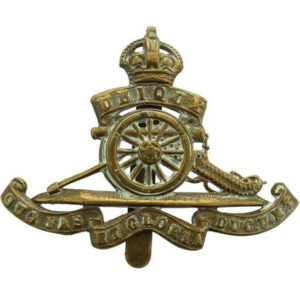
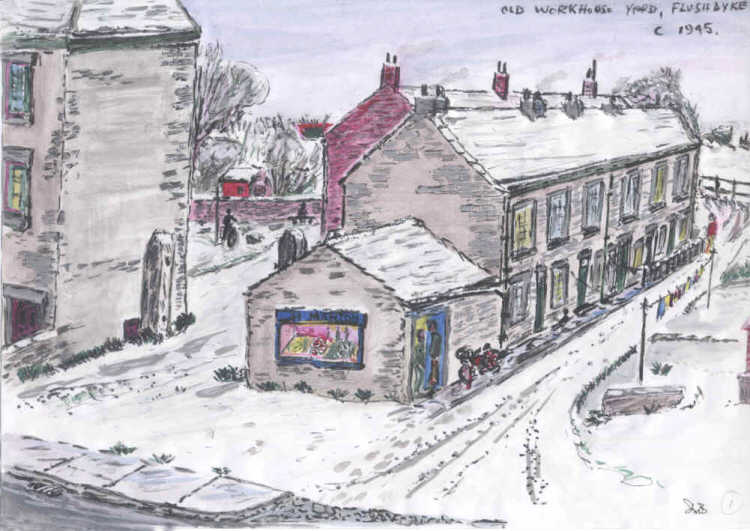
Before his death in May, Douglas Brammer ensured that the once-thriving community of Flushdyke would be remembered well into the future
Douglas Morton Brammer left behind a remarkable legacy. Using his photographic memory and artistic skills, he created a series of sketches capturing the spirit of a long- gone community.
When Douglas was born in Flushdyke, in 1937, it was a bustling self-contained suburb of Ossett, with churches, chapels, shops, pubs and a school. But, by the 1970s, most of it had been subsumed into a sprawling industrial estate.
Today, few pictures remain of the village, but Douglas’ ninety or so sketches ensure it will not be forgotten. And, in September, they will be published in a book, with all proceeds going to a worthwhile cause.
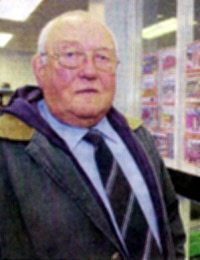
“My brother drew these sketches primarily for his own purposes,” said his sister, Margaret Wilby. “He was a very sociable person but modest when it came to his own abilities. The sketches of Flushdyke and later of Ossett were drawn over many years whenever some- thing triggered a memory and he wanted to recreate the moment visually as well as in his mind.
“Having shared many of these experiences with him over our early lives, I was very interested and asked him for copies of his work for myself. I put these away and did not share them until about ten years later when I showed them to my son and his wife. Their reactions gave me the confidence to then show them to local historian Alan Howe, with whom I had become acquainted through our interest in local history.
“He put a wider value on the images as someone who knew from maps and a few photographs what had once existed but was now long-gone. The rest is history, as they say, and a lot of hard work by Alan is bringing them to a wider audience and hopefully giving them a longer life than they might have had.”
Alan described Douglas as “a remark- able man” and said his sketches were of “immense historical importance”. “His photographic memory, sense of community and artistic skills have captured the history of a part of Ossett, Flushdyke, that is long-gone,” he added. “His life and his love of his community are reflected in every single one of the sketches he gifted to the community.
“In his sketches of Flushdyke, in particular, he has captured a world swept away by industrialisation in the early to mid 1970s. Not just the buildings, many of which are now no more, but also the people, the character, the spirit, the very being of that community. They are unique.
“These sketches are no copy of photographs. They are from his phenomenal memory, from his mind and from his heart. They are a pictorial biography of Douglas Brammer’s life.” Born just before the Second World War, Douglas and his sister, Margaret, attended Flushdyke Council School where their mother, Eleanor, was a highly respected dinner lady. Their father, Sydney – who had been one of the first pupils at the school when it opened in 1912 – was away, serving with the Army in East Africa. In 1946, he resumed the managership of the local Co-operative store.
Work, school and places to play were all within walking distance of their home. “Flushdyke was a community, even though it didn’t have a centre. It was divided by the A638 road – an old Roman route. Social life revolved around the school, Bethel Chapel, St Oswald’s Mission and the Co-op,” recalled Margaret. “It was a happy place to live and I have many good memories. Everyone watched out for each other.”
At eleven, Douglas went to Ossett Grammar School. One year, for his art exam, he was told to paint a picture of a cricket match, but his portrayal was not of a conventional scene. It depicted urchins playing cricket in a back alley, with the wicket chalked on a wall. “My brother saw interest and value in less conventional things,” said Margaret. “He never romanticised anything and had no pretensions.”
After leaving school, he worked in the engineering industry and was a union convenor. He completed a Certificate in Industrial Relations at Leeds University and then studied for a Diploma in Social Work at Huddersfield University, later becoming a probation officer and social worker. “He always saw the worth in people,” said Margaret. “He did not do things for rewards. He was a very modest person, who was sensitive and observant. He cared about people.”
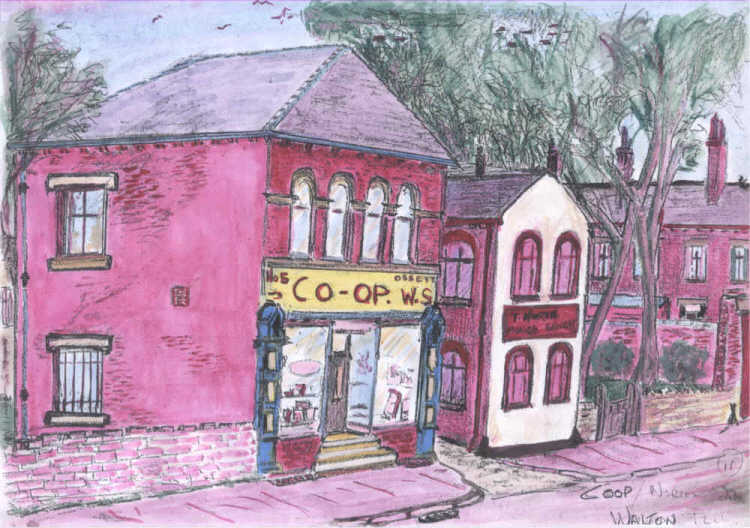
Flushdyke Co-op where Douglas’ father was manager for ten years
The inspiration for his sketches was a pub conversation with his friend, Don Boocock, in which they recalled how, in the 1960s and 1970s, the village had been decimated. The close proximity of the M1 had made Flushdyke a prime location for development. The community was soon overwhelmed with factories and traffic. Homes were seized, demolished and replaced with huge steel buildings and warehouses.
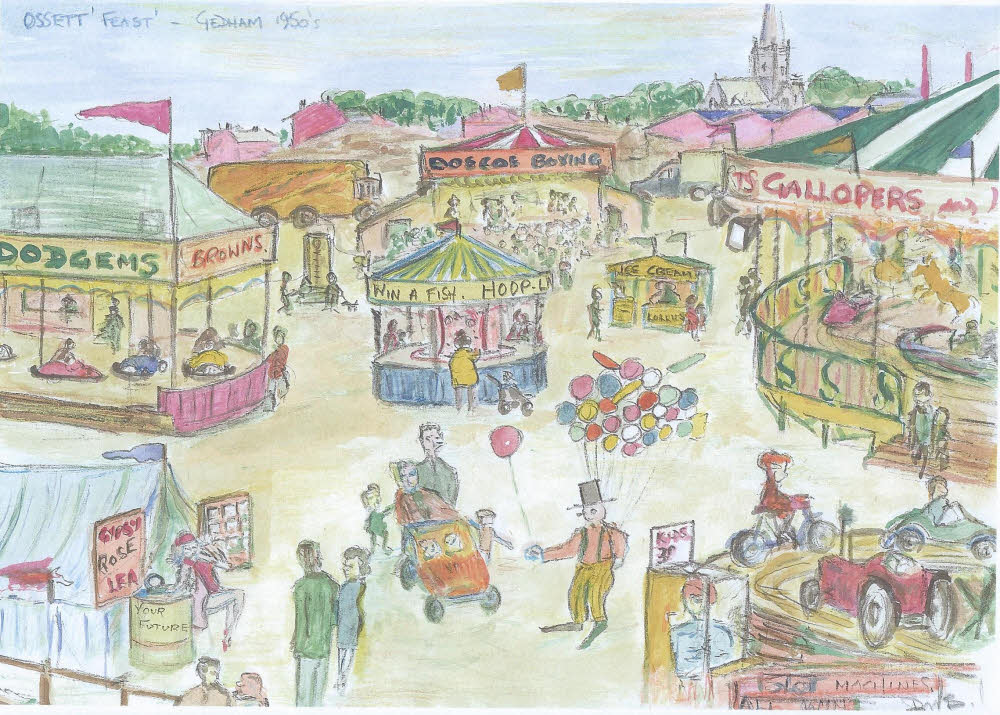
Ossett Feast
Other friends in the pub became interested in their recollections and wanted to know where these places had been. It was then Douglas realised that there was little photographic record of Flushdyke from before it was swept away by the industrialisation.
Later that week he drew his first sketch. It was of Workhouse Yard. And, like his subsequent sketches, it showed the essence and the spirit of the area as it was in the 1940s and 1950s. Another of his sketches was of Longlands House, which sat in its own grounds, where Douglas delivered newspapers as a thirteen-year-old. Sixty years later, he drew it from memory as the house was one of those demolished in the 1970s.
“A photograph subsequently emerged of the house, which showed the amazing accuracy of Douglas’ drawing,” said Margaret. “It gives credence to his other works. The sketches provide a walk through our early life.”
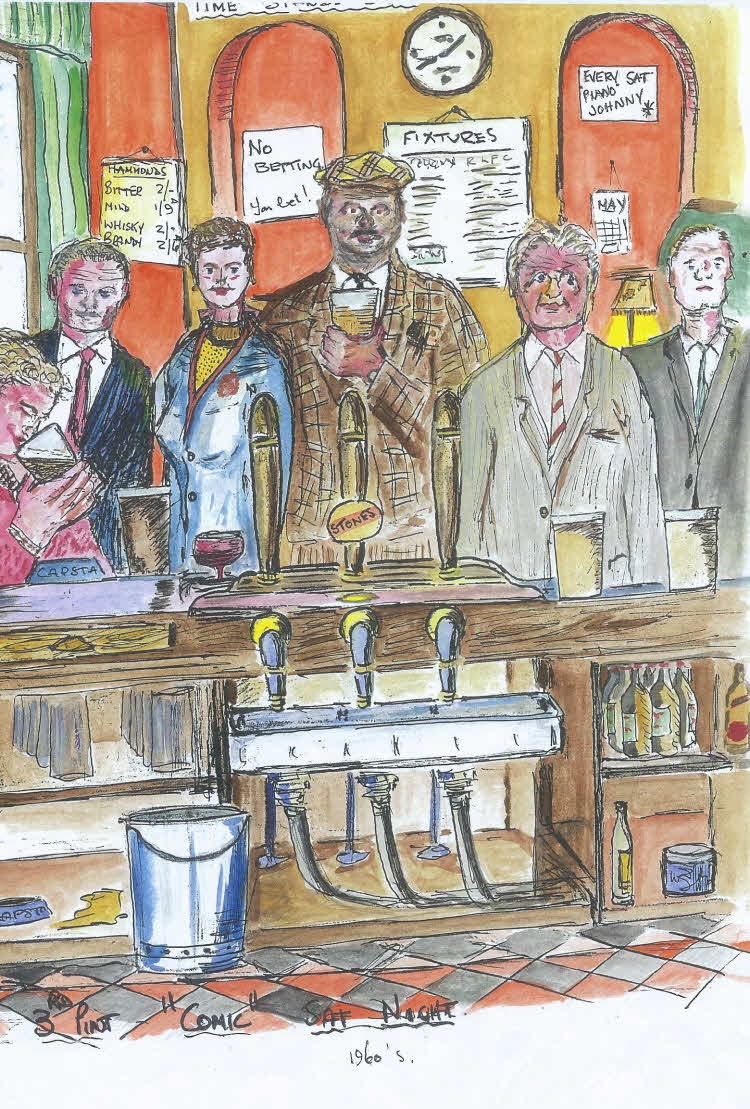
Drinking mates at The Commercial Inn, also known as The Comic
Douglas is also credited with helping Drinking mates at The Commercial Inn, also known as The Comic to save Flushdyke School – another of the places he drew in his sketches. Serving as chairman of the govern- ors, he led opposition to Wakefield Council’s proposal to close the school in the 1990s. The authority was concerned that it did not have its own catchment area, but Douglas argued that instead of closing an excellent school and transporting children from Flushdyke to other areas, children from surrounding areas should be brought in so they too could benefit from a smaller, quieter, more attentive environment. The closure plan was abandoned and, as a result, Flushdyke School continues to serve local children today. Douglas’ artistic legacy also lives on – not only through his sketches, but also the imminent publication of a book containing his work. Ever the modest man, Douglas was hesitant in the beginning but became gradually accepting of the idea. Sadly he passed away before the project could come to fruition, but family and friends pressed on and, later this month, Sketches of Past Times Flushdyke and Ossett, will be published. It contains almost 100 of Douglas’s’ sketches, accompanied by maps showing their location and a social and historical narrative. The book will be available from Ossett Library in the town hall. Meanwhile, you can view the entire Brammer collection here
Miss Hannah Pickard (1838-1891) was a member of a prominent Ossett textile family and lived her later life at “Green Mount”, at the junction of Southdale Road and Ossett Green. Ossett grocer and draper, George Pickard (born 9th April 1798, a Quaker birth) married Hannah Mitchell (born 1805) in 1824 and they had four children, two boys and two girls: Sarah, born in 1826; David born in 1830, Andrew born in 1835 and Hannah born in 1838. The family lived in a cottage, said to be where “Green Mount” would later be built. The Pickard family had existed in Ossett for generations.
When Miss Hannah Pickard passed away at her home, Green Mount, Ossett, on 29th June 1891, she left behind an estate worth in excess of £174,486. Hannah had inherited her fortune from her father, George Pickard, and her brothers David and Andrew. Having only one living heir, her nephew George (who died the following year aged 21), she set about making sure her wealth would be distributed near and far for the good of the poor and needy. The “Ossett Observer”, dated Saturday, 11th July 1891, published a list of bequests totalling £34,950 contained in her will.
Institutions from Leeds to London were named but her home town was certainly not forgotten. Her legacy to Ossett included:
It was this last bequest which was to provide the most visual reminder of Hannah.
The Corporation chose a design by local architect Mr W. A. Kendall and a team of contractors including Messrs R. Tolson and Sons – masons, Mr P Wills – sculptor (who also supplied the granite), Mr J W Appleyard – sculptor, Leeds (who carved the figures near the base), and Messrs J Snowden & Son – plumbers, who carried out the work.
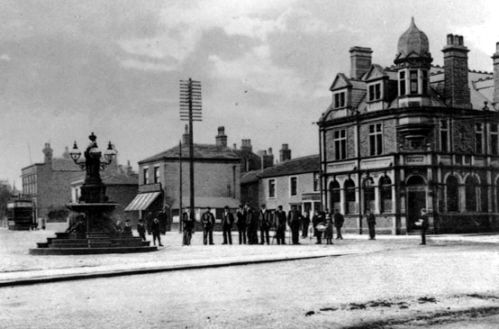
Left: The Pickard Fountain, Ossett circa 1900.
The “Ossett Observer” dated Saturday 28th October 1893 described the fountain and the opening ceremony:
“It occupies a conspicuous position near the centre of the Market Place, and is a very ornamental structure. Standing on a circular base of Aberdeen granite, the fountain itself is mainly of Bolton Wood stone, enriched with figures and other carving; but the shaft and massive bowl are of polished Peterhead granite. On the shaft is carved a lion (which is the crest of the Pickard family), the borough arms, and the following inscription:”
‘”This fountain is the gift of the late Miss Hannah Pickard, of this town, to the Corporation of Ossett for the benefit of the inhabitants and was erected in 1893. W A Kendall, architect.” The whole is about 15 feet high, and four gas lamps are attached to the upper portion. The water flows into the bowl already mentioned, and from thence into four drinking troughs for cattle and as many smaller ones for dogs.”‘
The opening ceremony took place on Saturday, 21st October 1893. The Mayor, Cllr. F. L. Fothergill was the guest of honour. The “Ossett Observer” set the scene:
“The members and officials of the Corporation, representatives of the Chamber of Commerce, Tradesmans’ Association, and Cooperative Society, with other gentlemen, met at the Temperance Hall, and, headed by the Borough Band, walked in procession to the fountain, which was surrounded by a crowd of two or three thousand spectators.
The Town Clerk (Mr Willie Brook) read two letters, which had been addressed by Mr J J Jackson, one of Miss Pickard’s executors, to the architect. The first stated that the executors were unable to attend, and suggested that the Mayor should undertake the opening. The second, which was dated 8th September, intimated that, owing to a sharp attack of bronchitis, there was no chance of the writer’s attending the ceremony, but trusted that everything would pass off well and that the good folks of Ossett would be pleased with the results of Mr Kendall’s labours. Mr Brook also read an extract from Miss Pickard’s will.
The band then played “Auld lang syne.”
The Mayor, in official robe and chain, informed those gathered that:
“Although he had not known the late Miss Pickard personally, he was informed that she was a very benevolent lady, always good to the poor, and they had some proof in the fact that she had bequeathed five sums of £1,000 each for the relief of the poor in her native town, and also two sums of £2,100 each for the foundation of scholarships. He trusted that the fountain would be kept in order and long remain an ornament to the town and not be allowed to become a nuisance as some people rather feared might be the case. The water was then turned on, and his worship filled one of the drinking cups and drank prosperity to the borough. His example was followed by several others.”
Other Councillors also spoke highly of Hannah and her generosity. Alderman Clay said:
“…the donor of this chaste and beautiful fountain was a lady of very kindly and benevolent disposition, as shown by the large sums which she had bequeathed to charities, not merely in Ossett, but in other parts of the country. Her kindness in this instance had been shown by providing one of the essentials of life for man and beast. He hoped that the fountain would stand as a memorial of her goodness and generosity for many generations to come, and that the inhabitants generally would endeavour to preserve it in all its beauty. He trusted also that other ladies and gentlemen who had the means would endeavour to beautify their native town.”
Alderman Wilson moved a vote of thanks to the Mayor and also spoke in complimentary terms of the design and construction of the fountain. Alderman Mitchell seconded the motion and added that:
“…other wealthy persons in Ossett had died, and their money had gone out of the town; but Miss Pickard had bequeathed large sums for the benefit of the inhabitants. The late Mr Gunson, of Scarborough, an Ossett gentleman, had also made provision for the erection of some almshouses. He hoped that others would follow suit in leaving a portion of their wealth to the town in which it had been made. The resolution was carried by acclamation.”
The Mayor replied that it had been a pleasure to him to perform the task and that he considered the fountain a credit to the architect and contractors, indeed everyone who had had a hand in its construction. Councillor J. W. Smith motioned and Mr W. Patterson, president of the Chamber of Commerce seconded a vote of thanks to the architect and contractors. Mr. Kendall briefly replied on behalf of the contractors and himself.
“…the old stocks used to stand on the site of the fountain, but he was pleased to see the old bogey replaced by something more beautiful to look upon and useful to both man and beast. A nobler woman than Miss Pickard had never lived, and had she lived longer she would have been a yet greater blessing to the poor of the borough. He hoped that her example might do something to spur others who were quite as able but not so willing (a laugh).
The band then played the National Anthem and the procession returned to the Temperance Hall, where nearly 30 gentlemen were entertained at tea by the Mayor. At the conclusion of the repast, several complimentary speeches were made, and thanks accorded to his worship.”
It must have been quite a spectacle to see. Unfortunately, the sentiments of the Mayor and Alderman Clay were to be fairly short lived as, by the early 1950s, the fountain no longer had its ornate lamps and the water troughs had been converted into flower beds. Sadly, in the late 1950s the decision was made to remove the fountain from the town centre. It was eventually relocated to Green Park where it remained until 2007. After suffering vandalism and neglect, a decision was made by Wakefield District Council to scrap the fountain. Most of it was given to a landscape gardener, Adrian Richardson, who took it to his farm in Sharlston.
Helen Bickerdike, May 2016
 In the cold winter months of 1846, a baby son Eli was born to a hand-loom weaver, Mathew Henry Townend and his new wife Hannah who lived in a small cottage in old Church Street, near the centre of the town of Ossett. Eli Townend was baptised at the Old Church in Ossett on the 15th March 1846. 23 year-old Matthew Townend had married Hannah Harrop at Dewsbury in the summer of 1845. Eli was to be the first of their family of seven children.1
In the cold winter months of 1846, a baby son Eli was born to a hand-loom weaver, Mathew Henry Townend and his new wife Hannah who lived in a small cottage in old Church Street, near the centre of the town of Ossett. Eli Townend was baptised at the Old Church in Ossett on the 15th March 1846. 23 year-old Matthew Townend had married Hannah Harrop at Dewsbury in the summer of 1845. Eli was to be the first of their family of seven children.1
Sadly, Eli Townend had a bad start to life when he was born with a serious impediment to his eyesight, which made it impossible for him to learn how to read and write. The Townend family were desperately poor with many mouths to feed and young Eli never attended school. This was before the days of compulsory education and his parents couldn’t afford the one penny a day to send him to one of the schools in the town.
Eli Townend later recalled his childhood days in one of his speeches:2
“This was when the families of working men rarely saw new milk, never saw butter and seldom touched meat and when the head of the family earned 12 shillings a week for nine months and nothing for the remaining months.”
Eli’s father Matthew died in 1870 at the early age of 48 and Matthew’s wife Hannah also died some three years later aged 49; their lives probably shortened by poor diet, disease and the primitive health care of the times. From this uncompromising start Eli Townend was destined to become one of Ossett’s most notable and successful citizens. A noted philanthropist and people’s champion, Townend became a wealthy factory owner who devoted over forty years of his life to serving the public of Ossett and was fondly remembered when he died in July 1910.
When Eli was 8 or 9 years of age, and to supplement their meagre income, his parents became caretakers of the “Saloon” on Bank Street, which was not a drinking establishment modelled on those in the American wild west, but was in fact a Temperance club, more often referred to as “t’owd saloon” by the Ossett locals.3 In the 19th century, Ossett people had a strong tradition of support for the Temperance movement, where the drinking of any alcohol was eschewed in favour of teetotalism. The “Saloon” was open to all classes of people, but was patronised largely by working men who went there in the evenings to play board games such as whist, chess and draughts; to read the daily newspapers and to discuss the topics of the day.
It was here that young Eli developed his remarkable mental faculties by listening to the conversations of the patrons, analysing what was being discussed and eventually storing a huge fund of knowledge on many varied subjects in his receptive young mind. Eli Townend would constantly add to this knowledge and use it to very good effect in later life.
SUCCESS IN BUSINESS
Eli Townend’s rise in the world was rapid, but his first few jobs were menial. As a lad, Townend started work at an early age, doing any available job that was suitable for someone with very weak eyesight. When the “Ossett Observer” was first published in 1864 by Mr. T.R. Beckett, it was 15 year-old Eli Townend who operated the handle on the primitive printing press.
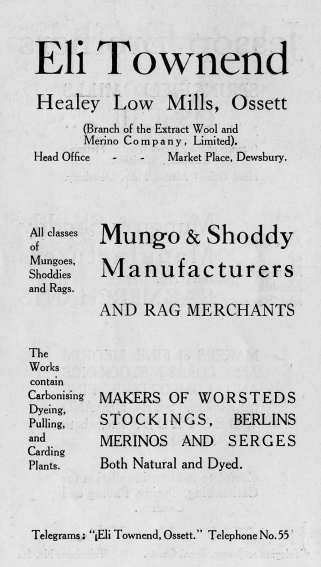 He continued this task for on a weekly basis for for some time afterwards. Townend’s connection with the “Ossett Observer” continued in other ways long after that employment ceased and it was he that that laid the foundation stone of the Borough Printing Works, the opening ceremony taking place at six o’clock in the morning. In fact, for 25 years, Townend saved every issue of the “Ossett Observer” and subsequently presented the bound volumes to Ossett Library.
He continued this task for on a weekly basis for for some time afterwards. Townend’s connection with the “Ossett Observer” continued in other ways long after that employment ceased and it was he that that laid the foundation stone of the Borough Printing Works, the opening ceremony taking place at six o’clock in the morning. In fact, for 25 years, Townend saved every issue of the “Ossett Observer” and subsequently presented the bound volumes to Ossett Library.
Coming back to Eli Townend’s early work experience; he worked for a time at Healey Old Mill and then as a rag grinder for Mr. Henry Westwood, who had successfully contracted for the rag grinding at the Ellis Brothers’ Victoria Mill. However, always seeking to improve his lot, Townend started to supplement his earnings by establishing an early take-away food business by selling hot peas to hungry pub-goers who were wending their way home after an evening’s drinking in the many hostelries around Ossett. In the 1860s, wearing the cotton smock, which he only discarded as part of his normal daily wear when he retired from business forty years later, Eli Townend was a familiar figure to the residents of Ossett with his billy can of hot peas in the Market Place.
Townend was probably heavily influenced by his time at the Temperance Saloon because in his earlier days he was a teetotaller and non-smoker. This lasted until he was 35 years of age, but he always declared that he was “a teetotaller in principle, only lacking in practice.”
Always thrifty, Townend saved the money from his work as a rag grinder and from his hot pea venture until the real turning point came in his career. He saw and, importantly understood, how some enterprising Ossett men were doing well in the rag business, which was taking over from cloth production in the town as the main commercial activity. Townend speculated and spent all his savings on buying a bale of rags, which he then sold on at a good profit.
At first, Townend was in partnership with a friend and the business blossomed. Eventually, the partnership was dissolved and Eli continued in his own right for another 30 years or so as Messrs. Eli Townend from 1870 at Healey Low Mills as a mungo and shoddy manufacturer. Townend was a tenant of Healey Low Mill, but didn’t own the place outright. Although the business was established before the great rush of competition began and during a period of good profits, Townend was able to steer the company through some difficult periods in the intervening years with a mixture of shrewdness, sound judgement, hard work and careful business methodology.
As a businessman, Eli Townend had a reputation for straight dealing. With him, a personal undertaking was as good a security as a legal bond and he gained the complete confidence in those with whom he dealt.
As an employer, he maintained excellent relations with his work people and whilst he required a fair day’s work for a fair day’s pay, he used to say that a request for an increase in wages was an offence to him, because when a man’s work was worth more, he did not need asking. In 1900, Eli Townend retired from business, handing over control of the firm to his youngest brother George Townend.
At the same time, in July 1900, Messrs. Eli Townend joined the Extract Wool and Merino Co. Ltd. syndicate, which amalgamated several other Ossett mungo & shoddy businesses such as Giggal & Clay, Jessop Brothers and Fitton & Sons (based in Earlsheaton, but the Fittons lived in Ossett) in order to maximise buying power and to reduce business overheads.4 The firm was still trading as “Mesrrs. Eli Townend” as late as 1927. 5
FAMILY LIFE
Eli Townend married Ossett girl Sarah Ann Lockwood in the March 1868 quarter in the Dewsbury Registration District (probably in Ossett). They had at least four children: Emma born in 1868, Hannah born in 1873, a son Harvey born in 1875 and Ada born in 1877. Sarah Ann Townend died in the June quarter of 1898 aged 55 and Townend married his second wife Eleanor Clarkson in the September quarter of 1898, just a few months after his first wife had died. Eleanor herself died in Huddersfield, aged 48 in 1908.
In the 1881 and 1891 censuses, Eli Townend was listed as a mungo manufacturer living with his family at “Calder Villa” in Healey Lane not far from Healey Low Mill. By 1901, he is living with his new wife Eleanor and son Harvey at “Calder Villa”, but now as a retired mungo manufacturer. It is thought that “Calder Villa” in Healey Road was long-since knocked down, but in Townend’s time the house had huge greenhouses and all kinds of interesting plants and ornaments in the garden. When Eli Townend died in 1910 he left his house to his son Harvey Townend.
 Eli Townend’s younger brother Frank Townend also started out in Ossett as a rag merchant, but after a family fall-out, he moved to Cut End Mill in Dewsbury and then later bought Spring Mill at Carlinghow, Batley in 1903. The billhead dated 1927 to the left suggests that Frank Townend & Sons were doing quite well at Spring Mill, which clearly was quite an extensive operation. Two of Eli’s brothers, Walter Townend and Harrop Townend were also rag merchants in Ossett. Youngest brother George Townend was part of the Eli Townend business management team at Healey Low Mill.
Eli Townend’s younger brother Frank Townend also started out in Ossett as a rag merchant, but after a family fall-out, he moved to Cut End Mill in Dewsbury and then later bought Spring Mill at Carlinghow, Batley in 1903. The billhead dated 1927 to the left suggests that Frank Townend & Sons were doing quite well at Spring Mill, which clearly was quite an extensive operation. Two of Eli’s brothers, Walter Townend and Harrop Townend were also rag merchants in Ossett. Youngest brother George Townend was part of the Eli Townend business management team at Healey Low Mill.
Although Townend wasn’t able to write anything more than his own signature and was never able to read, this didn’t deter him from a lifelong quest for knowledge. He simply got his family and friends to read to him from books and newspapers. This greatly increased his already formidable intellectual capacity, which was limited in his youth by the handicap to his eyesight that dogged his life. Greater wealth allowed him to indulge in a passion for foreign travel and he visited several European countries, Egypt and the USA. On all these visits he collected mementoes of his journeys including many rare specimens. He collected among other things a valuable museum of natural history specimens housed in the greenhouses at his “Grange View” home on Healey Road.
A LONG PUBLIC CAREER
Townend was to commence an impressive public career in 1882, in his mid-thirties, when he was elected as a member of the Ossett Local Board and the Dewsbury Board of Guardians (who dealt with the Poor Law at the Dewsbury Workhouse, which included the Ossett poor.) Always a controversial figure, largely because of his negative stance on the vaccination of children against diseases such as smallpox, Townend’s election to the Ossett Local Board was opposed by those who didn’t know him better or appreciate his abilities. In his election address to the Local Board he protested against the “scurrilous assertions and slanderous statements, which are freely scattered”, assertions which as the “Ossett Observer” remarked at the time, “he appeared to have suffered less than his fellow candidates for his severest critic in print admitted him to be a man of undoubted energy and ability.” This was an accurate description, for on the Local Board, Townend proved to be one of the most active and progressive members. He possessed a ready flow of blunt yet vigorous language, a rough but keen humour and with a good strong voice, he was an able and telling speaker.
One of his first important acts at the Ossett Local Board was to join those calling for the construction of public offices and, in 1906, the Town Hall was finally built. Although supposedly a Liberal in politics, Townend demonstrated socialist ideals well before socialism and the Labour Party were fashionable. For example, in a time when most working class people rented the property that they lived in, he pressed for rates to be levied on the owners of the property instead of the occupants. Similarly, Townend wanted manufacturers to pay water bills, maintaining that otherwise the working classes would suffer hardship. He wanted public baths and recreation grounds building in Ossett and was the lead proponent for the purchase of the Wesley House estate for a public park and public offices following the death of William Gartside. Not always successful in some of his lofty aims, nevertheless he was a strong supporter for a School Board and for a public cemetery. He remarked in one of his characteristic speeches that if sanitation continued to improve, the cost of which was “saved in coffins”, then a cemetery would not be needed because “they had got the death rate to 10½ (per thousand head of population) and if they knocked that off, they would all live forever.” Following a fire at a local mill, he proposed that the question of purchasing a steam fire engine should be referred to a “thinking committee”. He strongly supported the first resolution passed by the Ossett Local Board in favour of applying for a Charter of Incorporation. However, in a speech in which he said that the dignity of municipal borough was desirable as long as there was nothing extra to pay for it. For one of Ossett’s greatest improvements, the construction of Station Road, Townend was on the the side of the opponents, who were strongly against the scheme. Upon the incorporation of the borough in 1890 he was elected one of the first members, but on the expiration of his term of office, he did not seek re-election, retiring from public life altogether, but he was prevailed upon to become a member a candidate in 1903, and he continued to sit until his death.
In October 1889, Townend, now calling himself an Independent Liberal candidate, was elected a member of West Riding County Council and later, after the death of Mr. John J. Mitchell an Alderman. He was elected in the face of considerable opposition from amongst others, the Medical Officer of Ossett’s Local Board, Dr. John W. Greenwood, who at a selection meeting proposed “that Mr. Townend is not a fit and proper person to represent the division on the County Council for the next three years.” Townend had strong, even extreme views on many subjects, but particularly on compulsory vaccination. He and his brothers were fined for not allowing their children to be vaccinated and this was the root of Dr. Greenwood’s opposition to Townend. Other Ossett notables of the time such as Mark Wilby and Charles T. Phillips were also strongly opposed to Eli Townend being their representative on the West Riding County Council. However, Townend had strong support from the Ossett Conservatives led by his uncle, Gawthorpe schoolmaster, Benjamin Harrop.6 Once successfully elected, Townend lobbied for the management of the Poor Law to be transferred to the County Councils.
At one period of his life, he was a member of the Ossett Local Board (which met fortnightly), the Dewsbury Board of Guardians (1882 -1894) and the West Riding County Council and on each of these bodies he was known for his strongly independent attitude. Though wealthy himself, Townend respected neither wealth or person. A “son of the soil”, his sympathies were always with the working classes. As a member of the Local Board and the Board of Guardians, he fought many a protracted battle on their behalf. As a guardian, his sympathies with the poor who applied for relief were profound and usually exceeded his legal mandate. He opposed salary increases for Workhouse officials, insisting that the poor rate was for poor people and not to pay their exorbitant salaries and to him, money spent on lawyers was money thrown away. This made him popular and he was assured of being elected to any office where Ossett people had the power to elect him. A formidable opponent in local elections, Townend was always elected at the top of the poll (with only one exception), or returned unopposed. However, he declined the chairmanship of the Local Board and the opportunity to become the mayor of Ossett.
OPEN-HANDED GENEROSITY
From what has been written, it is easy to see how Eli Townend made many political enemies with his uncompromising stance on life. However, this was a man who practised what he preached and this excerpt from his obituary in the “Ossett Observer” reveals his true philanthropic nature:
“But perhaps the phase of his character which earned him most of the respect and popularity in which he was held was his large-heartedness and his extreme generosity to those in need. His bluff, rugged exterior; the robust humour which, especially in the time of his vigour, was a marked characteristic; his independent, freelance, hail-fellow-well-met attitude, were combined with a tender gentleness towards those in circumstances the hardship of which he himself had felt. To hear of a needy case was to put his hand, often deeply, in his pocket, and he heard of them frequently for he was the one to whom scores nay, hundreds of persons turned for assistance in their difficulties. To render it was to him a pleasure. At Christmas, it was his practice to distribute blankets and coals among poor persons who were in receipt of poor-law relief. He has given as many as ninety or a hundred loads of coal in a year in this way. Only last Christmas, we believe the number was about ninety. Every local cause, which had for its object the relief of suffering had in him a liberal supporter. He was the mainstay of the Ossett District Nursing Association, an organisation in which he took a deep interest, subscribing handsomely to its funds. Public celebrations were several times made the occasion for liberality towards the old or poor folk of the borough, or the children, the latter of whom, as well as the former had in him a good friend. During his membership of the Dewsbury Board of Guardians, the inmates of the workhouse had reason for regarding him in the same light. On one occasion, all the workhouse children were conveyed to his residence in Healey-road and there entertained by him. It may be stated on good authority that his charitable dispensations in these ways amounted to several hundred pounds annually, over a long period of years.”
DEATH AND THE FUNERAL
Eli Townend died on Saturday, 16th July 1910, aged 65, after several years of failing health that had caused him to sometimes miss taking his seat on Ossett Town Council. Latterly, his condition had gradually become worse and he was rarely able to venture from home. His heart was failing and he suffered from bronchitis. The end was hastened by a stoppage of the bowels and a day or two before he died, his condition became critical, causing him to lapse into a coma. At this stage, there was no hope and he never rallied, dying about seven o’clock on Saturday morning. His death caused widespread regret among the people of Ossett.
Eli Townend was interred at the Wesleyan Burial Ground, South Parade, Ossett on Tuesday, 19th July 1910. The flag at the Town Hall was hoisted at half-mast and a muffled bell was tolling. Flags floated at half-mast over Ossett Liberal Club and on other building in the town. Blinds were drawn on many of the houses lining the route of the cortège. Near his house in Healey Lane, a large number of people, mostly dressed in funeral clothes, watched the funeral procession and hundreds if others watched the cortège on its way to the burial ground. The procession was an unusually long one; the longest of this sort remembered in Ossett at the time. There were between thirty and forty mourning carriages bearing the chief mourners as well as members and officials of other public organisations, the work people from Messrs. Eli Townend, friends and acquaintances of the deceased as well as many representatives from business firms in the Heavy Woollen District. A large number of beautiful floral wreathes were received and filled two of the carriages.
In the vicinity of the burial ground a large crowd assembled. The service, both in the chapel and at the graveside was conducted by the Rev. C.S. Reader, superintendent minister. Owing to the large number of persons attending the funeral, the public were excluded from the burial ground during the service. Several members of the Oak and Ivy Lodge of U.A.O.D. of which the deceased was an honorary member and some of the oldest workmen of Messrs. Eli Townend acted as bearers. The funeral arrangements were carried out by Mr. G. Heald.
Eli Townend left £34,000, a considerable sum in 1910, as well as several Ossett properties, in addition to his home in Healey Road “Calder Villa”. In the 1911 Census, Eli’s second wife Eleanor is recorded as a widow still living at “Calder Villa” with stepson Harvey Townend.
References:
When Thomas Pierrepoint removed the safety pin from the gallows at Strangeways Prison at 9 a.m. on the 24th June 1926, the diminutive figure of 31 year-old Mrs. Louie Calvert dropped through the hatch and in 20 seconds her life had ebbed away at the end of a hangman’s rope. Resigned to her fate after her conviction in court, she went to her maker quietly and in dignified fashion. Louie Calvert was one of the few British women ever to to be hanged and this was the first female hanging at Strangeways since that of Mary Ann Britland in 1886.
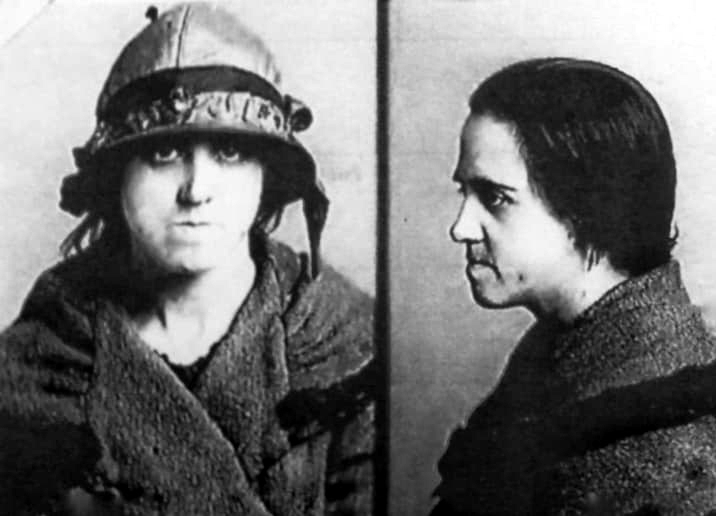
Above: Louie Calvert’s prison photograph taken shortly before she was hanged. This is the only known picture of Louie Calvert and is courtesy of Donna Johnson.
Her tragically short life had never been easy and Louie Calvert (nee Gomersal) had been dodging the long arm of the law ever since she was sixteen years of age. She had given birth to two children: a girl Annie and a son Kenneth, both out of wedlock, whilst she worked as a prostitute in the seedy parts of Leeds. There’s no doubt that she led a double life, fabricated by a web of intricate lies and she alternated almost “Walter Mitty” like between a make believe world as a Salvation Army convert and the grim reality of scratching out a life in industrial Leeds after WW1. When you anlayse her story, sometimes it is hard to decide who really was the victim. Did Louie Calvert really murder two people or was she so mad, bad and committed to petty crime that the judge and both the prosecution and defence lawyers effectively gave up on her?
Louie Gomersal was born in Ossett on the 12th January 1895, the daughter of woollen weaver Smith Gomersal and his second wife Annie Elizabeth (nee Clark). She was baptised at All Saint’s Church, Wakefield on the 14th April 1895. In 1901, the Gomersal family were living at Glenholme Terrace in Gawthorpe. Louie was the fourth of five children in the family. By 1911, the family had moved to live in nearby Pickersgill Street, and Smith Gomersal was now working as a caretaker at a school with Louie employed as a cloth weaver.
At the age of sixteen, in 1911, Louie Gomersal was bound over at Dewsbury Magistrates Court for for stealing £2 and for stealing 10 shillings in two separate offences of theft. This was just the start of her criminal career, and in July 1912, aged 17 years, she was sentenced to a year in Borstal for stealing a purse, a ring, a three-cent piece and a farthing from Mary Ann Carter on 25th September 1911 in Batley and £1 in money from Patrick Reynolds, also in Batley, on the 26th April 1912.
Louie Gomersal was short, thin, undernourished, not particularly attractive and coarse in manners. In fact, she was less than five feet tall, but what she lacked in height, she made up for in assertiveness by way of a very strong personality. It was said that some people found her intimidating and they were genuinely scared of her.
After leaving her home in Ossett, Louie Gomersal moved to Leeds, where she lived a hand-to-mouth existence as a prostitute. In about 1916, she gave birth to an illegitimate child called Annie, who went to live with Louie’s sister in Ossett. She also had a second child in 1919, a boy called Kenneth on whom she doted. Louie was fond of using an alias and for the Salvation Army meetings she sometimes attended, she used the name Mrs. Louise Jackson and also Edith Thompson when she was on the game.
In 1922, Louie using her “respectable” alias of Mrs. Louise Jackson, went to work as a housekeeper for 49 year-old John W. Frobisher, who lived in Mercy Street, lying between St. Philips Street and Wellington Lane, near the city centre of Leeds. On the 12th July 1922, Frobisher’s lifeless body was found 400 yards away from his house, near Monk Bridge, floating face down in the Leeds – Liverpool canal. He had a fractured skull and a massive head wound. Bizarrely, although he was found in the water fully clothed, Frobisher’s boots were missing.
Although suspicion fell on Louie Gomersal initially, the police did not investigate further. At the inquest, Louie appeared and she stated that she had pawned John Frobisher’s boots. Had Frobisher walked to the canal with no boots on? He lived a quarter of a mile away from the canal, yet the inquest recorded a verdict of death by misadventure and it was assumed that he had simply drowned. Louie continued to live in Frobisher’s Mercy Street house until she was evicted a few months after his death for the non-payment of rent.
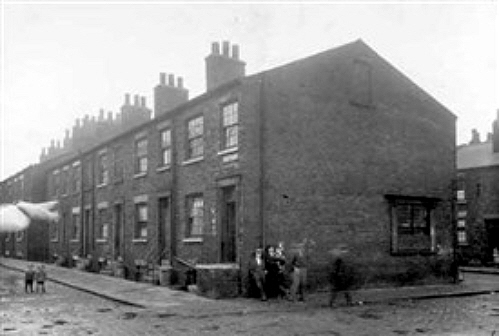
Above: Mercy Street, Leeds. The home of John Frobisher who was found dead in the Leeds-Liverpool canal on the 12th July 1922.
Arty Calvert, a poor night-watchman lived at 7, Railway Place in the Pottery Fields area of Hunslet, Leeds. In 1924, Louie went to live with Arty, ostensibly as his housekeeper, taking along her five year-old son Kenneth. Soon Louie and Arty were sleeping together and, after a while, Louie claimed that she was pregnant by him. Arty Calvert was old-fashioned and decided to do what he saw as being the right thing, so he offered to marry Louie. In the summer of 1925, the couple married in Hunslet, Leeds. Meanwhile, Louie managed to play out the deception that she was pregnant for some time. When no baby arrived. Louie initiated an elaborate web of lies. She wrote a note to herself, which she showed to the poor unsuspecting Arty, claiming it was from her sister in Ossett whom had invited her to stay during her confinement. After a brief visit to Ossett, she sent Arty a telegram to say that she had arrived, but in fact Louie had by then returned to Leeds.
Somehow, to keep the deception going, Louie had to produce a baby and she did so by the simple means of advertising in the local Leeds paper, offering to adopt a newborn child. A teenager from Pontefract had recently given birth to a baby girl and her mother saw Louie’s advert in the paper. Giving birth to an illegitimate child in the 1920s was regarded much differently to today and there was great stigma attached to such events, which were all too common. Adoption provided a way out for the Pontefract girl and her mother. It didn’t take long to arrange for the baby girl, who had been named Dorothy, to be handed over to Louie Calvert. Pretending the little girl was hers, and to explain her absence, she told Arty that the newborn was in hospital.
Instead of being at her sister’s home, Louie Calvert had actually taken up lodgings just two miles away from her husband’s house at Amberley Road, Leeds with 40 year-old widow, Mrs. Lily Waterhouse, a part-time prostitute and psychic, who to make ends meet rented out a spare room to working girls. Lily Waterhouse’s husband George had died aged 59 years about a year previously. She now lived in grinding poverty and squalor in the tiny rented terraced house with wooden boxes serving as tables, bare plaster walls and bare floorboards, except for newspapers under the mattress. Mrs. Waterhouse had been in poor health for some time and her post mortem revealed that she suffered with both scabies and body lice. Despite her ill-health, she survived mainly by prostitution and often entertained gentlemen back at the house. It was reported in one of the local newspapers by one correspondent that “she was suffering from a social disease”, which was a euphemism for some kind of venereal disease, although Lily’s post mortem didn’t substantiate this claim. It is easy for us to look critically at the morality of Lily Waterhouse, but these were very difficult times during a period of industrial unrest and staggering poverty. Making ends meet would have been difficult for a 40 year-old widow.
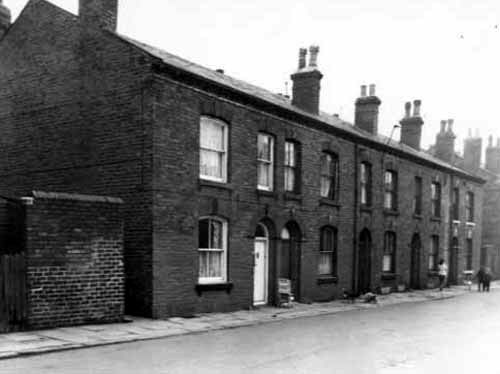
Above: Amberley Road, Wortley, Leeds, where Louie Calvert murdered Lily Waterhouse.
Louie Calvert’s role was to act as some kind of maid servant or companion for Mrs. Waterhouse, though as we see later, they worked together as prostitutes. Unfortunately, the two women soon proved to be incompatible and to make matters worse Louie refused to do any housework, and then started stealing Lily’s bedding and crockery, which she pawned. Discovering the thefts, Lily Waterhouse went to the police in Leeds to complain that her belongings had been stolen. Detective-Sergeant John Holland was assigned to interview Mrs. Waterhouse on the 31st March 1926, and he was well aware of her minor notoriety. Proceedings were started against Louie Calvert for theft, but that same night Mrs Lily Waterhouse was murdered. The killing had been a brutal one involving a “prolonged struggle before the knock out blow” and a “penetrating wound down to the bone” at the back of the head prior to strangulation. Lily had also been tied up.
Several neighbours heard the sound of a disturbance and loud banging from inside Mrs. Waterhouse’s house. Shortly after the commotion stopped, Louie left the house with the baby and was carrying a canvas bag with some crockery in it. One of the neighbours, a Mrs. Clayton commented to Louie that she had heard Mrs. Waterhouse making strange noises. Louie replied “Yes, I have left her in bed crying because I am leaving her.” Louie Calvert then caught the tram back to her marital home and her unsuspecting husband Arty.
Later that evening a policeman called at Amberley Road to find out why Mrs. Waterhouse hadn’t returned to the police station to sign the complaint she had made against Louie Calvert. After hearing about the strange noises from the neighbours, the policeman obtained a key and let himself in. There he found Lily Waterhouse lying on her bed, with her hands tied, battered about the head and strangled to death. She was fully dressed, except for her boots, which were missing. There was no sign of a struggle and the dust in the room had not been disturbed, suggesting she had been killed elsewhere and carried to her room once dead. The killer had cut up some cloth to tie Lily’s hands and feet, yet there must have been something else used to strangle her because the ligature marks around her neck were wider than those caused by the strips of cloth.
At last Arty had his wife back, and also what he thought was his baby, little Dorothy. This was a brief happy time for the Calverts. Unknown to him and bordering on the unbelievable, Louie had gone back to Amberley Road at 5 a.m. the next morning and filled a large suitcase with the few possessions left in Lily Waterhouse’s home. Her compulsion to steal hadn’t been diminished by the horrors of the previous evening and by the murder of Lily Waterhouse. Several neighbours at Amberley Road had seen Louie Calvert leaving the house at 5:30 a.m. with a large suitcase. Arty Calvert was also surprised to see the suitcase, that had not been there the night before, in the downstairs room when he got up the next morning. Even more surprisingly, when she returned to Amberley Road to steal more things, Louie had left a note to say she was collecting items that had been given to her by Lily Waterhouse. Had she not done that, there is a real possibility that she could have escaped undetected. Lily Waterhouse’s neighbours had no idea who she was and she had only been at the house about three weeks.
The police in the form of Detective-Inspector Pass soon tracked down Louie Calvert and made their way to the marital home at Railway Place in Hunslet. When Louie opened the door, she was wearing Lily Waterhouses’s boots and scarf. Maybe this was an echo of something that happened four years previously when her then employer John Frobisher had been found face down in the Leeds – Liverpool canal with his head bashed in and also missing his boots. The police worked quickly and efficiently and found Lily Waterhouse’s few possessions in the house and in the suitcase. Louie was arrested, but crucially not charged until 24 hours later, which formed the basis of an appeal later on.
Remanded in Armley Prison, and by now an ugly, wizened woman of 31 years without a tooth in her head, Louie was finally brought to trial at Leeds Assizes on the 6th and 7th May 1926, where, after a two-day court case, she was found guilty of the murder of Mrs. Lily Waterhouse. With the prisoner condemned by the jury, the judge Mr. Justice Wright, had few reservations about imposing the mandatory death sentence on the woman that stood in the dock before him. It was said that Louie Calvert received the notice of the death penalty with an air of calm indifference.
During her incarceration, Louie Calvert was described as below by the prison authorities:
“The prisoner has been known as a prostitute of a low type in Leeds for some years. She has a bad record of theft and house breaking that started from the age of 15. She has two illegitimate children aged 9 and 6 years. The prisoner is idle and of very dirty habits.”
Details of the trial are almost non-existent. Transcripts have not survived and there were no newspaper reports after the General Strike ended. Some information has been forthcoming from her Appeal, held on the 7th June 1926, which was fought on the grounds that “she was not charged within 24 hours after her arrest” and that during that time, she was subjected to an amount of questioning that exceeded what was allowable.
The appeal failed and the Lord Chief Justice responded that “nothing in the present case suggested that the police had gone beyond their duty.” He also felt that his summing up had been both “clear and fair”. He further commented that “Calvert did not give evidence, although her defence was that she was NOT the person who killed Mrs. Waterhouse.” Clearly, Lord Chief Justice failed to maintain a neutral attitude towards the fact that Louie waived her right to give evidence on her own behalf. He concluded the hearing by dismissing her appeal without calling upon the Crown to argue, and without legal obligation to consider the fact that 25 witnesses had appeared for the prosecution, whilst NONE had appeared for the defence. It seems likely that the Judge and the Defence deemed it likely that Louie Calvert was an unsuitable witness who would not make a good impression on the jury due to her social class, lack of education, personality and general demeanour.
Louie’s final act of desperation was to tell one more lie in the court room in a last bid to save herself by claiming that she was pregnant. Whilst it was hard to find any redeeming features with Louie’s personality, there was plenty of opposition to her hanging. Mr. J. Lambert, a Leeds City Councillor who observed the trial declared that he was “full of pity for the poor woman, whether she was guilty or not. She was a thin, wan-looking creature only weighing a few stones. I should never legislate on the lines of hanging for women.” Meanwhile, Dr. Watts an MP, felt sufficiently concerned about Louie’s supposed pregnancy to raise the issue with the Home Secretary through a Parliamentary question. Sir William Joynson-Hicks, the Secretary of State answered that: “Any doubt which may have existed as to the prisoner’s condition has since been dispelled, and it is now certain that there was no pregnancy.”
Nevertheless, as the date of Louie’s execution drew nearer, strenuous efforts were made to obtain a reprieve. The Labour MP for Consett, the Reverend Sir Herbert Dunnico organised a petition, which was signed by 3,000 people, many from Louie’s home town of Ossett. There was also a motion for an address praying His Majesty the King to exercise his Royal Prerogative in the case of Louie Calvert, signed by six Labour MPs. However, it was all to no avail and Louie Calvert was moved to Strangeways Prison in Manchester to await her fate.
Whilst awaiting her execution, Louie Calvert wrote her “Life Story”, which included her account of the events surrounding the death of Lily Waterhouse:
“I got into the company of the young women with whose death I am charged. We used to go out at night and visit public houses with the intention of getting hold of any man who had money, to get them drunk, then rob them of any money they had left. The last Sunday I was there, this woman brought a man home supposed to be a soldier from Beckett’s Park hospital for wounded soldiers. After he had been there a few days we began to quarrel about him. She wanted him, and he wanted me, but I wanted neither. I wanted to leave them and go home again as it was beginning to get a little bit too hot. The detectives were on our tracks and we couldn’t go out without them pulling up and getting us fined.
Well, on the Wednesday night, the day I was going to leave her, we went out and had a few drinks with this man and he fetched half a dozen pints of beer and stout home. After about half an hour we all started to quarrel and it got to fighting. Oh, the drink, it is the ruination of everything, for we do lots of things in drink and temper that we are most sorry for afterwards. Well he said something nasty to her and she landed out with her fist at him and they both rolled on the floor. When she got up and struck out again, I picked up the poker, which happened to be the nearest thing to me and my intention was to strike the man and make him leave off hitting her. Instead it struck her on the head through him dodging out of the road and she fell dead at our feet. He went mad and then got hold of a belt, strangled her and carried her upstairs. I got out and got home. God knows how I did it. I don’t.”
Louie’s account makes it quite clear that a man was present at the killing. A Home Office memo confirmed that the legal teams at the trial had knowledge of the man being present at Amberley Road prior to her trial, a fact borne out by the neighbours of Mrs. Waterhouse who had seen the man. The police, when they visited Louie Calvert on the day after the murder, had found a piece of paper in her handbag with the (Canadian) address of a man called Crabtree and enquiry was made regarding the recent movements of a miner named Frederick Crabtree, who was an out-patient at Beckett’s Park hospital.
Despite this evidence being provided by the Leeds police, when the Prison Governor passed Louie’s “Life Story” to the Home Office after her conviction, a civil servant noted “this is the first time the prisoner has told her story.” Fred Crabtree was actually summoned to appear in court as a witness, but he was never called.
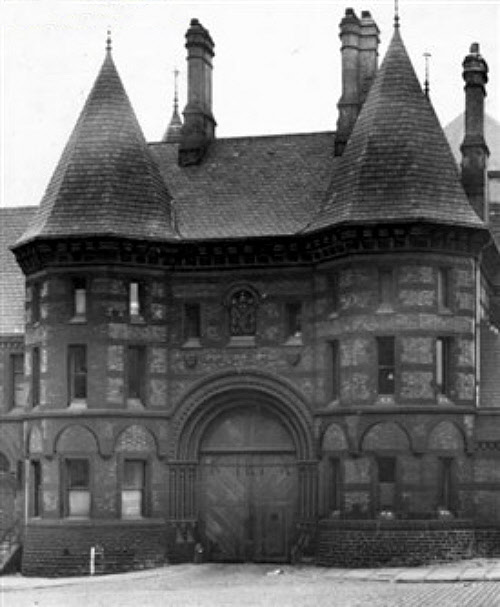
Above: Strangeways Prison where Louie Calvert was hanged and where she was buried in an unmarked grave.
Louie’s last request, before she was executed, was to see her 6 year-old son Kenneth and this was granted on her last afternoon when Arthur Calvert, her husband and Leah, her sister-in-law with young Kenneth all came to say goodbye. The meeting lasted half an hour and at the end, when the boy pathetically appealed to his mother to come home, he was told that she had to go to London to see the Queen.
On the 24th June 1926, the day of the execution at Strangeways Prison, a crowd of around 500 people gathered outside the prison walls. A little later than the usual time of 8 a.m. and upon a signal from the Prison governor, Thomas Pierrepoint, Britain’s most established hangman entered Louie’s cell, accompanied by two male prison warders. A woman warder told her to stand up and Pierrepoint took her arms and quickly strapped her wrists behind her back with a leather strap and then led the way out of the cell. Louie was led into the execution chamber and stopped whilst Pierrepoint marked out the letter “T” precisely over the divide of the trap doors. Pierrepoint’s assistant William Willis then put leather straps around her ankles and thighs. A white handkerchief was placed on her head, followed by a hood.
Pierrepoint slipped the safety pin out and the trap doors opened. Louie Calvert was dead in less than twenty seconds and at about nine o’clock, a strange hush fell upon a section of the crowd when a bell inside the prison began to toll in faint, ghastly tones to announce that the deed had been done.
Looking back on all the evidence, it has to be said that there must be some serious doubts about Louie Calvert’s conviction for the murder of Lily Waterhouse. Was Fred Crabtree really the murderer? There was little sympathy from the Lord Chief Justice given her criminal past and her appearance. However, there seems little doubt from Louie’s confession in her condemned cell that she murdered John Frobisher in July 1922. Sadly, we shall never know the truth about what really happened at Amberley Road.
References:
1. Gomersal family data – courtesy of Alan Howe, Ossett
2. “Yorkshire’s Murderous Women – Two Centuries of Killings” by Stephen Wade
3. “Reconceptualizing Critical Victimology: Interventions and Possibilities” by Dale Spencer and Sandra Walklate
4. “Dead Women Walking – Executed Women in England and Wales 1900 – 1955” by Annette Ballinger, a thesis submitted for the Degree of Doctor of Philosophy, September 1997.
5. “Daughters Of Cain: The Stories of Eight Women Executed since Edith Thompson in 1923” by Renee Huggett and Paul Berry
Thomas Tomlinson Cussons.
Thomas Tomlinson Cussons was born in Hull in 1838, the son of George Cussons and his wife Jane (nee Moss). Thomas had an older brother, William Henry. In 1867 he married Elizabeth Ashton at Louth in Lincolnshire. Some time between 1868 and 1870 he moved to Leeds and in the 1871 census he was recorded as being a chemist and druggist at 31 Stocks Hill. Thomas and Elizabeth had three children, John William Cussons was born in 1867 in Louth, Florence Cussons in Leeds and Alexander Cussons also in Leeds.
In 1880 he took over the chemist and druggist business of Richard Moore. He also took the position of postmaster at this time from Mr. Moore. He was already qualified as a chemist and druggist by examination.
The Ossett Observer reported at the time he had been working as a chemist in Louth, dispensing for doctors Sharpley & Higgins. I can find a Dr Sharpley in Louth in the 1860s but no Dr Higgins. In the 1861 and 1868 directories for that town there is no Cussons Chemist advertised so I assume he was working for another chemist before taking over his own business in Leeds. There was one chemist in Louth, Thomas Simons, who was also postmaster. Maybe Thomas worked for Mr Simons and learned his postmaster skills there too. By 1874 advertisements in the Leeds Mercury mentioned him as being at the Stocks Hill post office.
In his advertisement in the local press announcing his arrival in Ossett, he stated that he skilfully extracted teeth, as well as having:
“a large and well assorted stock of patent medicines at reduced prices. A choice assortment of hair, tooth, nail, shaving, painters and other brushes. Also combs, toilet soaps, sponges, perfumery and other toilet requisites. The same quality tea and coffee, for which this establishment has so long been noted, will also be kept in stock, and may be relied upon. Agent for W & A Gilbey’s wines and spirits, also for Bass’s beers and Guinness’s stout”.
Apart from also producing his own baking powder, an essential requisite in those days. he provided veterinary medicines, which he would continue to make up from Mr. Moore’s own recipes. In the 1881 census, he is recorded as living in Dale Street with his wife, three children and servant Charlotte Robinson, aged 19 years.
The premises in which he took over Mr. Moore’s business were in Wesley Street, facing inwards towards the market place, roughly in front of where the Lloyds TSB bank now stands. In 1882, two years after moving there, he had to abandon his premises as they were compulsorily purchased by the Local Board of Health for the widening of Wesley Street and he moved business to the other side of the Market Place. The old premises were sold by auction on Monday, July 17th 1882 and it was reported that the energetic demolition of the old house commenced the same evening, for the recovery of the building materials. His address was now “Commercial Buildings”. About this time, he was also refused a beer licence and had to give up that part of his trade, which had been carried on a long time by Mr. Moore.
Mr. Cussons had three children, John William (b. 1867), Alexander Thomas (b. 1875) and Florence (b. c1870). In May 1889 it was announced that his son John William had passed the Pharmaceutical Society’s examination, and was now qualified to register as a chemist and druggist. He had been educated at Wakefield Grammar School, and commenced work in the post office in May 1882 as assistant to his father, a few months before their move of premises.
 In 1892 Thomas Cussons retired his position as postmaster. He had seen 20 years of postmanship, the last twelve years of which were as a postmaster. For a while he had been running another chemist’s business in Swinton, near Manchester, with his son John William Cussons as partner. He now took the opportunity to move to take personal charge of that concern. John William Cussons took his place as postmaster, and was presented with a handsome pipe and a silver mounted walking stick by the staff of the Post Office.
In 1892 Thomas Cussons retired his position as postmaster. He had seen 20 years of postmanship, the last twelve years of which were as a postmaster. For a while he had been running another chemist’s business in Swinton, near Manchester, with his son John William Cussons as partner. He now took the opportunity to move to take personal charge of that concern. John William Cussons took his place as postmaster, and was presented with a handsome pipe and a silver mounted walking stick by the staff of the Post Office.
Pictured Right: John William Cussons b. 1867.
The business in Ossett continued to trade under the name of Cussons & Son. This was to be an important year in the life of John, for on Wednesday 22nd June of that year he married his fiancée, Catherine Wilby at South Ossett Wesleyan Chapel. She was a daughter of woollen manufacturer Mark Wilby of Manor House, Manor Lane.
By the end of 1892 they were advertising that they had a large stock of chemical apparatus and pure chemicals: “important to chemistry students”. An illustrated price list was free on application.
It appears business was doing very well, for in April 1893 it was announced that Cussons had secured a site for building new premises for his shop and Post Office, on the corner of Prospect Road and the new Station Road. This was a new thoroughfare in the town, and was being rapidly developed. The “Dewsbury Reporter” at the time stated that it “was fast becoming the handsomest street in the Heavy Woollen district”. It was to be a grand building, with Mr. Cussons’ residence forming part of the building, his shop being on the corner, and Post Office business having a frontage of 27ft on to Station Road. A stone, carved with his entwined initials was to be set into the end wall. In early March 1894 the premises were occupied for the first time, the new Post Office opening on Tuesday, 6th March. On 22nd March, John William gave a dinner at the Coopers Arms to celebrate the opening of his fine new premises.
In 1895 John William was again applying to the Ossett Brewster Sessions to gain a licence to sell beer for consumption off the premises. However, it was pointed out that within 300 yards of his shop there were eleven licensed houses, of which four were fully licensed, the other seven being beer houses. On the grounds of the number of licences already issued in the area, his licence application was refused.
In 1897, John William Cussons was elected Hon. Secretary of the newly formed National Sub-Postmasters Association, however, after only two years in the position he announced at their annual conference that he would have to retire from the position and he was instead elected as vice- president. Two years later in October 1899 the “Sub-Postmaster”, the official magazine of the National Federation of Sub-Postmasters, gave a portrait of John William, and biographical details. This portrait was reproduced in the “Chemist and Druggist” journal, which also gave the information that Mr. Cussons was also a member of the executive of the Dewsbury & District Chemists’ Association. In June the following year he was the recipient of a beautiful marble timepiece, as a token of respect of the sub-postmasters for his services to the national federation.
However, later that year it was announced that John William Cussons would be retiring his position. At the same time he was disposing of his business as a chemist and druggist. This was in consequence of having purchased the manufacturing drug business of Messrs. Sherratt & Co., of Harpurhey, Manchester. The latter had been amalgamated with a similar business in the same district belonging to his father, Thomas. The whole would be carried on as Cussons, Sons & Co., with John’s younger brother Alexander now being heavily involved in the family business. It was at this time that the Post Office in Ossett was to be separated from the family’s other business ventures and became independent. The Cussons business was to go from strength-to-strength, to become the household name of Imperial Leather we are now familiar with.
Ossett-Born Millionaire
At least one son of Ossett lived to become a millionaire, founding a firm which is known the world over. He was Alexander T. Cussons, younger son of Mr. T. T. Cussons, post-master and chemist, of Ossett Market Place. Father and son moved to Swinton, Lancashire where they began the manufacture of chemist’s products such as brilliantine and scented cachous, salts, etc.Mr. A.T. Cussons expanded the business and took over a derelict factory at Kersal Vale, Manchester, which he turned into a modern factory covering 14 acres. He concentrated on the manufacture of high-class soaps, cosmetics and talcum powder which are sold all over the world under the brand name “Imperial Leather”.
A nephew of W. Cussons is Mr. L.W. Cussons of Berry Lane, Horbury.
“Ossett Observer Jubilee edition”, July 4th 1964:
S. N. Pickard.
In November 1900 an advertisement appeared in the “Ossett Observer”:
“Mr. S. N. Pickard begs to announce that he has purchased the business of chemist and wine & spirit merchant, carried on successfully for many years by Mr. J. W. Cussons. Having had a large experience of the dispensing of medicines, analyses and pharmacy, he hopes to be accorded a fair share of the patronage from his many Ossett friends, and the public generally. The purest drugs and chemicals only employed. Patent medicines at lowest London prices. Note the address: S. N. Pickard, Member of the Pharmaceutical Society, Dispensing and Family Chemist, Station Road, Ossett”.
Samuel Norman Pickard, a native of Ossett, was educated at South Ossett Church of England school, and then at Ossett Grammar School, when it stood on the site of the present Town Hall. As a committed Christian, Pickard became a Sunday School teacher. He served his apprenticeship with George Saville, chemist, in Wakefield when he was 16 and qualified as a chemist from the South London College Of Pharmacy then later became a member of the Pharmaceutical Society after passing their examination, which included Latin, in the spring of 1886.
After this he went back to Mr. Saville for a short time as an assistant. He then moved on to become pharmaceutical dispenser at Clayton Hospital, Wakefield. Following this he took over the management of the business of Mr Handforth, chemist and dentist at 74 Manningham Lane, Bradford, around 1889 and subsequently acquired the business. He ran this business for 11 years before selling it to purchase the business of John William Cussons.
In March 1924 Mr. Pickard applied for transfer of his wines & spirits licence to new premises in Wesley Street, near to where the shop had stood, which Mr. Cussons had first taken when he moved to Ossett originally. The August 1st edition of the “Ossett Observer” for that year carried the advert:
“Change of premises: S. N. Pickard, chemist & optician, begs to announce that owing to expiration of lease he is transferring the business to larger and more commodious premises in Wesley Street, Ossett, which he hopes to open on Wednesday next, August 5th”.
This building was built around 1880 by Mr. J. Hampshire-Nettleton who ran his butchers shop from there before moving into the Market Place. Later, the premises were used as the town’s first Labour Exchange, before Mr. Pickard took up occupancy.
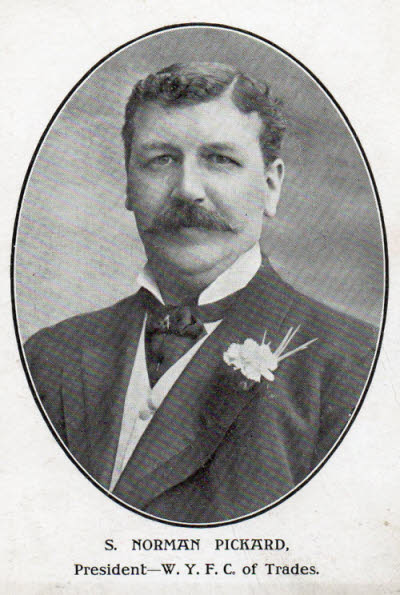
A little later, due to health reasons, he moved to Bridlington for a few years, but then moved back to Ossett shortly after war was declared. He celebrated his golden wedding anniversary on the 17th October 1943 at his home: The Knoll, West Wells Road. However, in November of the following year Pickard died in his 76th year. A photograph of Mr. Pickard was published in the “Ossett Observer” after his death. Mr. Pickard’s daughter carried on the business until his grandson, Mr. Ian Pickard Rigg, came out of the army and became manager of the shop in 1955.
Mr. Rigg had in his possession books in which prescriptions were recorded which had been dispensed, from earlier days. The first book contained 1,994 prescriptions. The last entry bore the date 1872 and the stamp of C. H. Lockwood, chemist, Dale Street, Ossett.
In August 1963 the floor space was increased by 50% after alterations. A new modern dispensary was built in a back room, which was formerly used as a kitchen. Shelves were fitted in the shop and stocked supermarket style so that customers could serve themselves from the displayed products. The shop offered a fine selection of wines and Mr. Rigg often travelled abroad to choose them.
The company had bought the business of D. Haigh, chemist of 140 Dewsbury Road, but after five years of being open this branch had to close in December 1970. It had run at a loss for the previous two years, with the staff of two being reduced to one.
Mathew Marsh
He was born in York in 1866, but the majority of his days as a youth were spent in Normanton, where his father, Mr. William Marsh, was employed by Messrs. Henry Briggs, Son & Co, colliery proprietors. After he left Normanton National School, In 1881, Mathew Marsh took employment with Job & Carr, chemists, of Normanton and Wakefield. He stayed there until 1887 and for the last five years there, he was an articled apprentice. His father left Normanton to take up the position of deputy at Old Roundwood colliery in Ossett, and after living in Alverthorpe for a short while he moved to Ossett where he lived for 36 or 37 years before he died on “Peace Night” in 1918.
After leaving Job & Carr’s, Matthew Marsh was employed for two years by Messrs. George Exley & Son, pharmaceutical chemists, Leeds, following which he became manager to Mr. John Day, chemist, Savile Town, Dewsbury. He was married in Leeds in 1891 to the daughter of an Armley builder, and shortly afterwards he moved to Great Stanmore in Middlesex, as manager to a chemist & druggist there. In 1895, he moved to Ossett where he commenced his business in Horbury Road, “Marsh’s Medical Hall”, opposite South Ossett Church, before moving to Victoria Buildings further along the road in 1900.
During his residence in Ossett he took a keen interest in public matters, and associated himself with many useful movements of the day. He was a staunch churchman as a sidesman at South Ossett Church and he also sat on the church council. For several years he was Hon. Secretary of the South Ossett Working Men’s Institute, and a founder of the club in Belmont House. In gratitude for his services here he was awarded in 1906 a handsome marble clock and bronze ornaments.
He first took interest in local government matters in 1909 when he opposed Mr. Walter Townend, an ex-mayor, in the East Ward, and was returned by 398 votes to 192, a considerable victory. In 1912 he had a landslide victory, and since there were no elections during the Great War, he was not contested until 1919, when he was opposed by Mr. Alfred Renshaw, whom he defeated by 567 votes to 543, after the keenest contest in the history of the ward.
Marsh always sat as an independent, not being affiliated to any political party. While in office his administrative skills were soon recognised and in 1914 he was elected Chairman of the Sanitary Committee in the town council. While he was involved in public affairs he worked tirelessly. He represented the corporation at the Royal Institute Congress at Birmingham, Folkestone and Newcastle, and his reports of these and other conferences on health matters were always interesting and instructive. He was prominent in connection with the organisation of the festivities in association with the coronation of King George V in 1911, and was in charge of the festivities at Southdale School, where the schoolchildren of the borough were entertained to tea. He was similarly active when the king and queen visited Ossett in 1912, and at the peace celebrations in 1919.
During the Great War he proved himself a useful member of the Food Control Committee, and also acted as a Special Constable from October 1914 until the force was disbanded. His duties here included night patrol, where he would have been watching for air raids, and also the important matter of distributing butter and margarine. He was also a member of the Belgian Refugee Committee. It was these and other interests in public matters which eventually led to him being elected as Mayor of Ossett in 1921.
Don Cawthra had premises at 7, Prospect Road, Ossett until the late 1960s, when he moved his blacksmith’s shop to the old Spa Mill, Ossett Spa. Don was Ossett’s last working blacksmith and what follows is a short summary of his life and a few anecdotes. My thanks to Steve Armitage for the use of his photographs and for his recollections of Don.
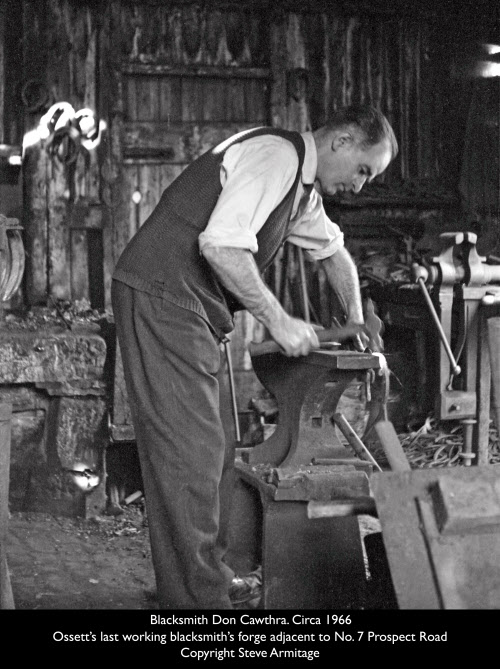
Steve Armitage recalls:
“As young boys, my brothers and I would visit Don Cawthra’s Stithy frequently, our family home was in Brook Street off Prospect Road and but a short walk away. It was an unforgettable experience to visit this black pitch-coated timber “lean-to” building. The dark and smoky interior consisted of a forge with a coke-fuelled furnace, an anvil and various assorted tongs and irons scattered about the smoke-stained work surfaces, shafts of light coming through cracks in the timbers added to the exciting atmosphere. The right half of the building was a horse stall where the horseshoes would be trial fitted whilst still hot from the forge. My first abiding memory was the rhythm of the anvil as Don hammered and shaped red hot iron into horseshoes, “clang, clang, clang, clang, clang, clang, cla-clang”, always six single beats and the extra beat and a half!
Then there was that SMELL, like nothing I had experienced before or since, pungent, acrid smoke rose to the rafters as the red hot shoe was pressed into the horse’s hoof that was held firmly against Don’s leather apron. Once impressed into the hoof, a good and tight fit was ensured and the shoe was cooled before finally being nailed to the hoof and filed carefully to ensure there were no sharp projections. Don’s party piece (designed to impress junior onlookers) was to take a glowing coal from the furnace, drop it into his leathery hand and toss it casually from palm to palm “would THA’ like t’ave a go-a?” he always asked. No takers, but memories that have lasted a lifetime!”
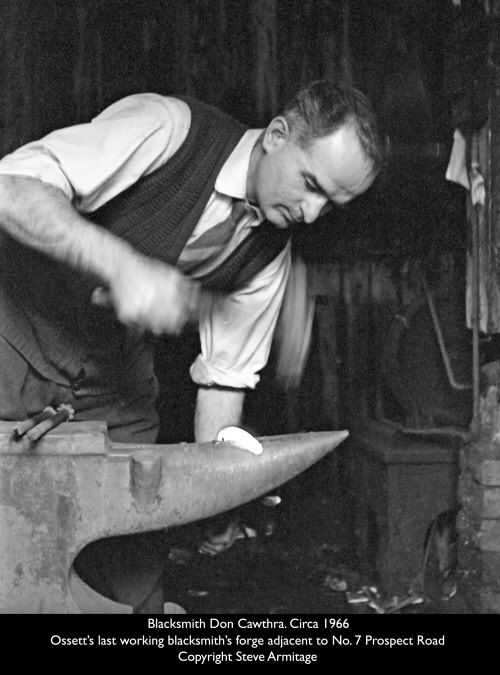
Donald Cawthra was born on the 31st January 1929 and his birth was registered at Dewsbury. He was the son of miner Joseph Cawthra and Lily Hepworth who were married on the 9th October 1926 at St Barnabas Parish Church, Liversedge. Joseph, of Tanner Street Hightown, was 23 and Lily, a wire reeler of Clare Road, Cleckheaton, was aged 25. In addition to Donald the couple had another son, Stanford, who was born in June 1927. Sadly, Lily Cawthra, died in September 1938 aged only 36 years. Don was only 9 years old when his mother died. It’s not known when Joseph and his sons moved to Ossett.
Don used to live with his father Joseph Cawthra at 10 Park Street, Ossett. After his father’s death,in 1973, at the age of 69, Don moved to live in a house at the junction of Headlands and Westfield Road. The house is still there and fronts on to Headlands Road. Sometime later Don moved to Fairfield Road, Ossett, much closer to the Spa than Westfield Road, where he remained before moving to live in residential accommodation at Fitzwilliam.
He never married. When he wasn’t at his forge he could usually be found in the Royal on Bank Street. Not a man to rush home it is said that he always bought himself a couple of pints just before “chucking out time”. He was also well known locally as a featherweight boxer.

Above: Picture of Don Cawthra shoeing a horse belonging to John Myers on the right, believed to be early 1970s. The photograph shows the position of the lean to forge mentioned by Steve Armitage, with the building behind which is still there, but with the high level window blocked up. The Dewsbury & District Directory 1961 records D. Cawthra, Blacksmith, on Prospect Road in Don would then have been 32 years of age.
Alan Howe recalls Don Cawthra well:
“Don Cawthra was our smithy from the early 1980s (probably about 1982) but by then he had moved from Prospect Road to John Myers’ Spa Mills where he set up his smithy shop. The building in which he set up is still there, dating back to the 1960s or so. It was single-storey building on John’s land and fronting Spa Lane. The unremarkable building is still there and is now used as a stable. Alan’s wife Pat recalls Don visiting her pony, Brandy, a rescue, she took on in about 1982, and which the Howes kept at Haggs Hill Farm in those days.
Don came down to the farm to try to shoe him. Brandy had been knocked about a bit before we got him and he didn’t like men; even nice men like Don. He couldn’t get near him and when he did, he couldn’t shoe him at the farm. So Don’s solution, uttered in typical Don understatement was: “Get that wooden bugger dah’n to my shop afore ‘e kills somebody an a’hl rope ‘im up and sort him theer.”
In those days you did what you were told by the smithy and off we went. Don was ultimately successful, but Brandy always had to be fed treats to keep him calm on later visits. Sadly, Don had to have a leg amputated later in his life and moved from his Fairfield Road terrace home (opposite the 4th Bn KOYLI Drill Hall) into Residential accommodation. A friend of ours, sadly no longer with us, used to visit him regularly. He was a small built man, but a real character and kind at heart.”
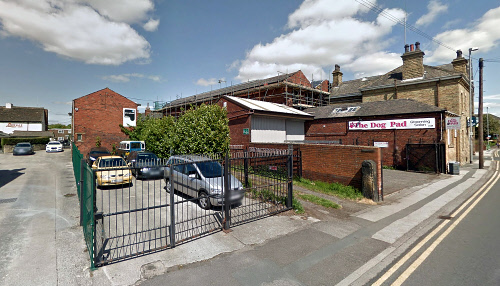
Above: The site of Don Cawthra’s Ossett forge was inside the car “compound” adjacent to No. 7, Prospect Road, Ossett. The original line of the forge’s sloping roof can still be seen on the wall of the brick building behind the Landrover. Picture by Steve Armitage.
Alan Howe’s wife Pat recalls another Don Cawthra anecdote:
“In those days a hoof moisturiser called “Cornucrescine” was very popular to help with cracked hooves. You can still buy it today and a claim for the product was (and is) that it was:-
“Unique and wonderful – promotes and accelerates healthy horn growth and aids re-structuring of the hoof when used regularly. Also aids re-growth of hair on scars and rubbed areas.”
Don was less than convinced about it and especially the claim that it was good for hair growth. Pat took Brandy down to him on one occasion and was talking to Don about the cornucrescine elixer and asked him if it was true that it helped hair growth. Don was a quiet man, and in typical fashion, actions spoke louder than words. He whipped off his cap (which he almost always wore), pointed to his balding plate and uttered: “Nah then lass does tha’ think I’d ‘av an ‘ead like this if it worked?”
We stopped buying it after that.”
Don Cawthra died in July 1996 aged 67. His death was registered at Wakefield. Don’s elder brother, Stanford, died three years later in August 1999.
Horace Brooke was born on 11 April 1898, the second son of Lionel and Mary Brooke. Horace had a sister Ada and four more brothers, Leonard, Albert, Ernest and Gilbert. The family lived on Cross Street, Gawthorpe and later they moved to High Street. Lionel ran a milk round. The family were active members of the Bethesda Methodist Church in the village and the children attended the village school.
Horace showed an early aptitude for art and according to the Dewsbury & Batley Advertiser (24th December 1953) he was taken under the wing of local artist Arthur Oldroyd. Wilfred Gledhill was his teacher when he attended the Ossett Municipal Technical School as a part-time student between 1910 and 1913, he appears to have also have been working as a farm hand during this period.
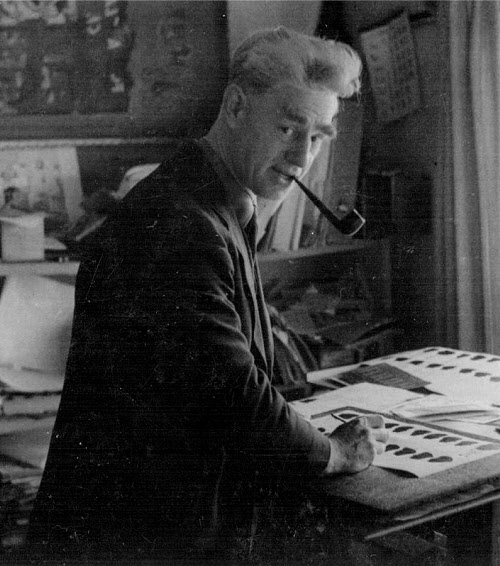
Above: Horace Brooke working in his studio 1950s.
Between 1913 and 1915 Horace attended Leeds School of Art, Horace’s granddaughters still own a substantial collection of his artwork – there are sketchbooks, prints and paintings from this period which illustrate his aptitude. Unfortunately, his studies were interrupted when he enlisted in the Green Howards at Richmond on the 18th November 1915. Fortunately, his service papers survive and, although his age is wrongly recorded as 19 years and 7 months, suggesting that Horace wasn’t entirely truthful about his age on enlistment. Horace had a rather up and down career in the army. On the 8th June 1916 he was promoted to Corporal, but two weeks later he was a Sergeant. However, following a disciplinary charge, he was demoted back to Corporal, but was soon promoted again to Sergeant.
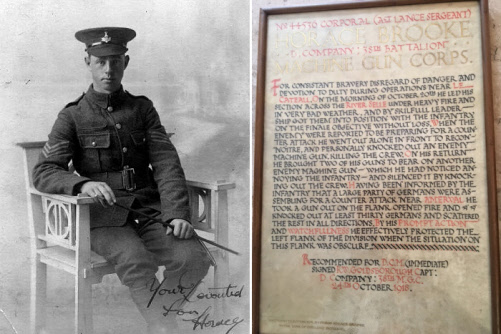 Above: Sergeant Horace Brooke with his DCM Citation during service with the “Suicide Squad” or Machine Gun Corps.
Above: Sergeant Horace Brooke with his DCM Citation during service with the “Suicide Squad” or Machine Gun Corps.
Sergeant Horace Brooke transferred to the Machine Gun Corps and won the Distinguished Conduct Medal for his bravery in October 1918 during heavy fighting during the Battle of the Selle near Le Cateau in France when he personally knocked out an enemy machine gun killing the crew whilst out alone in No Man’s Land on a reconnoitre mission. You can read the full story of Horace Brooke’s WW1 exploits by clicking on the link of his name.
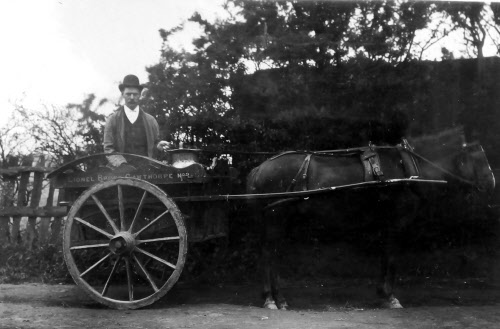 Above: Lionel Brooke with his horse and cart, delivering milk around Gawthorpe.
Above: Lionel Brooke with his horse and cart, delivering milk around Gawthorpe.
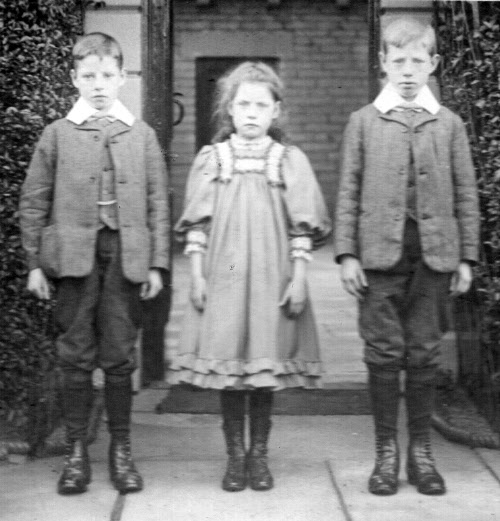
Above: Leonard, Ada and Horace Brooke circa 1907.
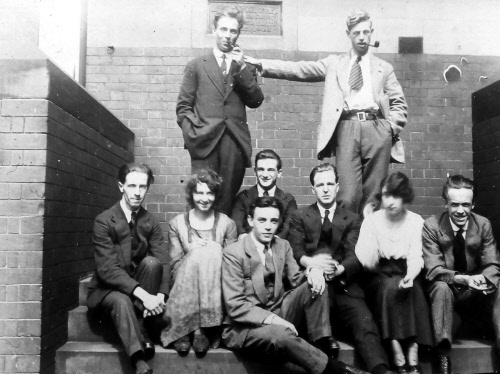 Above: Horace Brooke (standing top right) with fellow students at Leeds School of Art circa 1920. The man seated (third from right) in front of Horace Brooke is famous sculptor Henry Moore. Picture also includes George Stevenson, and is reproduced with kind permission of George Stevenson’s daughter, Anne and son George Stevenson.
Above: Horace Brooke (standing top right) with fellow students at Leeds School of Art circa 1920. The man seated (third from right) in front of Horace Brooke is famous sculptor Henry Moore. Picture also includes George Stevenson, and is reproduced with kind permission of George Stevenson’s daughter, Anne and son George Stevenson.
At the College Horace’s main study was painting, but he also studied architecture, drawing and engraving. His reports record that he was “an excellent student”, “an able draftsman” and “a hard worker”, although one dissenting voice describes him as “an earnest student, not very gifted, but improving!”
He contributed to the RCA’s student magazine and provided designs and decorations for the common room socials. When he graduated with a diploma in Drawing and Painting in July 1924, he was photographed with fellow students who included Eric Ravilious, Albert Christopherson, Charles Tunnicliffe, and Douglas Percy Bliss, who all went on to have distinguished careers in the arts.
One of his close friends at the college was fellow student Ba Nyan, who had travelled form Myanmar (Burma) and had a key role in promoting western painting techniques to Myanmar artists when he returned home. Ba Nyan visited Gawthorpe with Horace and stayed with the family and once he had left England he kept in touch.

Above: Horace on graduation from the Royal College of Art in London. He is fourth from left on the back row wearing a mortar board hat. His close friend Ba Nyan from Burma (Myamar) is next to him, third from the left.
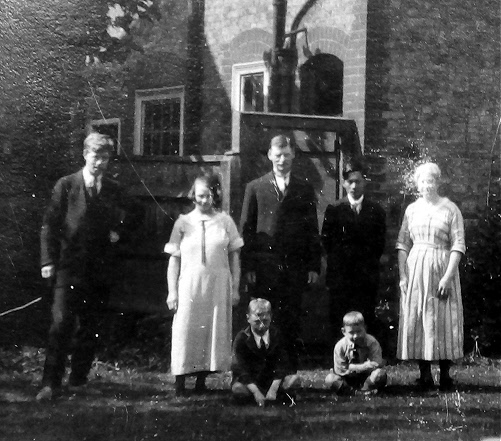
Above: Ba Nyan on a visit to the Brooke family in Gawthorpe. L to R: Horace, Elsie his wife, Lionel Brooke, Ba Nyan, Mary Brooke. Horace’s two younger brothers Albert and Ernest in front.
In May 1925, the Yorkshire Post reported that Horace was represented in an exhibition at the Royal Academy, his work was shown in an open competition for scholarships for the British School in Rome, the newspaper noted “Among the engravings the work of Mr Horace Brooke has much to commend it, ‘Grassington Bridge’ is particularly well done”, a subject he returned to many times. The following paragraph mentions Barbara Hepworth’s entry.
His annual RCA admission forms record his desire to become a “Painter and Black and White artist” (printing) although on his last form, in 1924, a perhaps more realistic future as a “Teacher or Black & White artist” is recorded. He was fond of self-portraiture and there are several examples of his talent for “black and white” art, for example the self portrait below:

When Horace left the RCA in July1925 he set up a design business with fellow RCA students E Sutton and W Twibell. The business was known as The Regent Studio and was based in Knightsbridge and the trio focused on ‘Design, engraving, illuminating, lettering, decoration, stone carving, illustrations, posters etc’.
It’s not clear when Horace ventured out on his own, but by 1931 he had established himself as a commercial artist in St Albans. On the 14th August 1923, Horace of 18, High Street, Gawthorpe married his long-time sweetheart, Dewsbury girl Elsie Evelyn Lovell at the Bethesda Chapel in Gawthorpe. In 1924 Elsie gave birth to their son Howard.
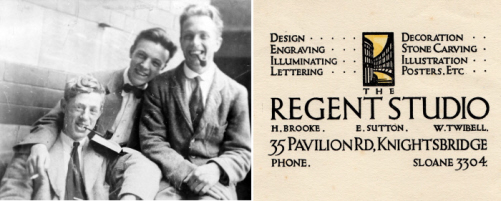
Above: Horace Brooke (left), it is thought with with E. Sutton and W. Twibell, founders of The Regent Studio, Knightsbridge, London in 1925.
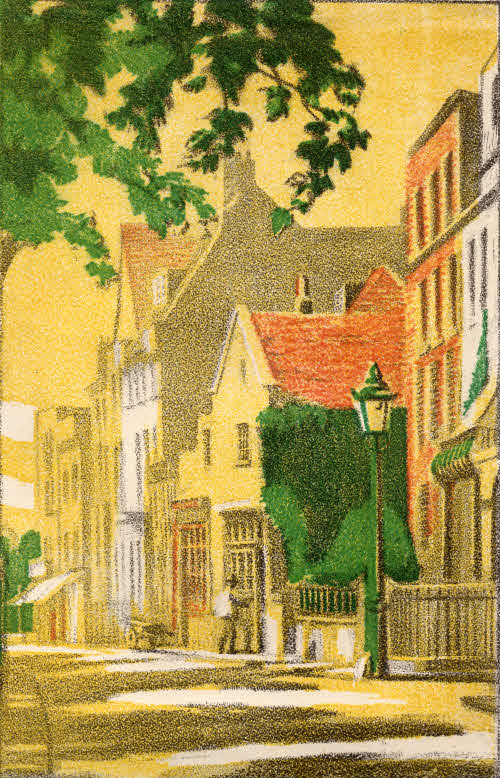
Above: Horace Brooke print from the Regent Studio period.
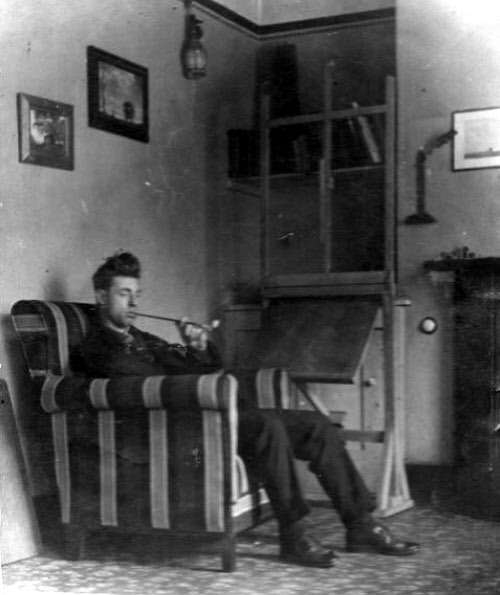
Above: Horace Brooke looking all Bohemian in the late 1920s.
Like all commercial artists, Horace worked on a mixed range of projects for a varied array of clients. Work ranged from a small bookplate, to illustrations to promote art paper produced by the paper company Balston. During the Second World War Horace served his country again and also produced drawings for the local paper to promote the purchase of a spitfire on the front cover of The Herts Advertiser in August 1940.
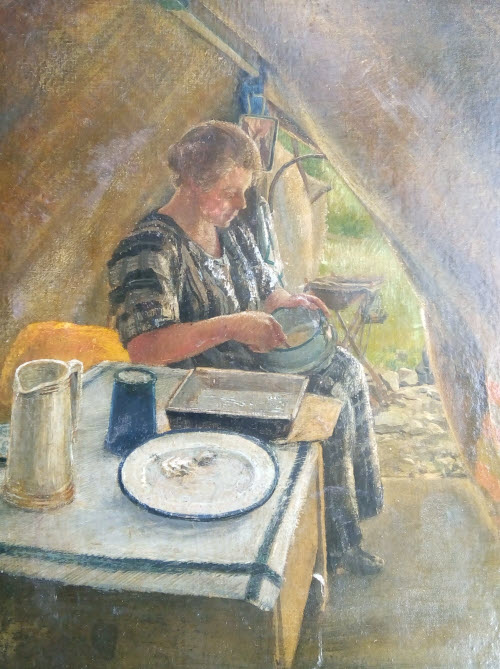
Above: Portrait of his wife Elsie by Horace Brooke.
Although Horace had made his home in the south, he was very attached to Yorkshire. He travelled to see family including his birthplace, Gawthorpe, where his sister lived, and he went on camping trips to the Dales, especially to Grassington. He later took his caravan north for holidays. He took a regular job for the Yorkshire Woollen District Transport Company of creating the covers its staff magazine as well as its company Christmas cards. Horace continued painting and printmaking exhibiting in the Royal Academy Summer Exhibition in the 1950s.

Above: Horace Brooke’s depiction of Gawthorpe Maypole celebrations.
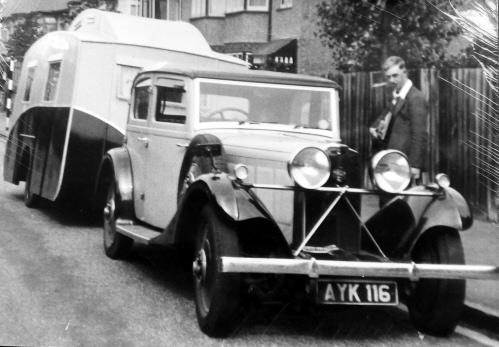
Above: Horace Brooke and his touring caravan in which he often visited his beloved Yorkshire circa 1930s.
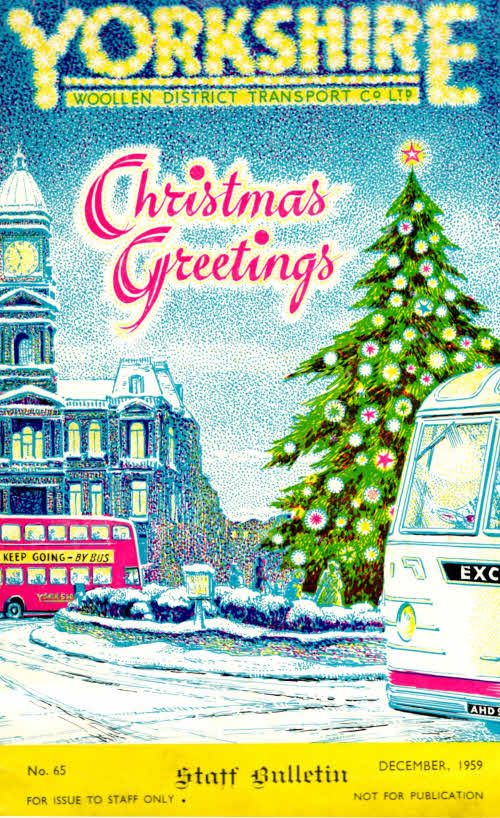
Above: Commercial work done by Horace Brooke for Yorkshire Woollen District Transport circa 1962.
After retirement, Horace and Elsie returned to their beloved Yorkshire and he taught art at Heckmondwike Senior School before opening a sweet shop at Daisy Hill, Dewsbury. Elsie died in 1958 followed seven years later by Horace.
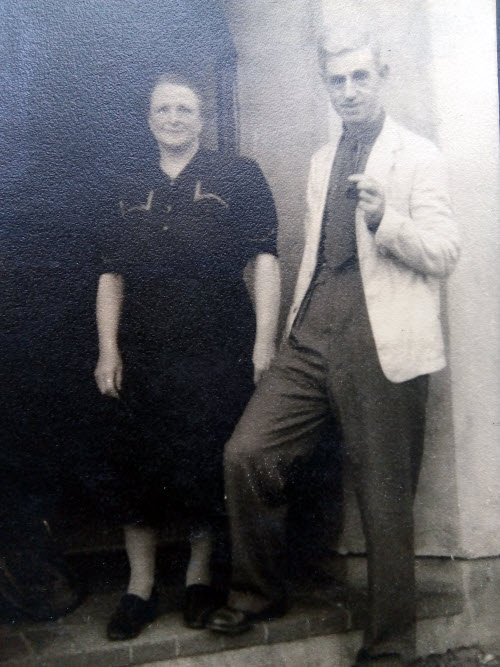
Above: Horace and Elsie Brooke in the 1950s.
The stories of Horace and his brother Leonard Brooke illustrate the contrasting fates of two soldiers who fought in the First World War, Leonard cut down in his prime at the age of twenty-one and Horace who went on to marry, have a family and enjoy a successful career building on his artistic aptitude.
Horace’s story is also of interest as he is one of many art-school-trained individuals who did not reach the heights of his fellow students, Moore, Hepworth and Ravilious – however, he is more typical of the many whose talent was recognised and then nurtured at art school allowing them to earn a living from their talents.
Dr Christine Boydell
For more information about Horace Brooke and many more pictures of his work, his life and his family please take a look at Christine’s Blog Festival of Pattern by clicking on the link.
Acknowledgments
Most of the images in this article are owned by the family, particular thanks to Jacqueline Smith (Horace’s granddaughter), Mary Clay (Horace’s niece) and Andrew Clay (Horace’s great nephew). Thanks also to Neil Parkinson (RCA), Kate Gilliland (Leeds College of Art) and Keith Rowntree (Leeds Beckett University) Christine Boydell is the partner of Andrew Clay
 Zbigniew Franciszek Klatkiewicz was born in Oporów, Poland on March 28 1922. He had dreamed of being a pilot ever since he was a child. But, as his dreams began to come true, World War II broke out and his family lost sight of him for over half a century.
Zbigniew Franciszek Klatkiewicz was born in Oporów, Poland on March 28 1922. He had dreamed of being a pilot ever since he was a child. But, as his dreams began to come true, World War II broke out and his family lost sight of him for over half a century.
Zbigniew Klatkiewicz’s war had begun whilst he was still a cadet at Szkola Podoficerow Lotnictwa dla Maloletnich (SPLdM), the Polish Air Force Non Commissioned Officer’s School for Minors. Prospective candidates were between the ages of 16 and 17 years and had to attend two days of rigorous examinations, be physically fit and possess the recognised aptitude required by the Polish Air Force (PAF). Zbigniew’s first year would likely have consisted of drill, physical training and formal learning of military regulations. By the end of the year the authorities would have selected those who would go forward for pilot training. Due to the pressure to train more pilots a satellite airfield was opened at the end of July 1939 and this is where Zbigniew Klatkiewicz was on September 1 1939 when Germany invaded Poland. At 6am almost thirty German airplanes attacked the school. It is reported that over 60 aircraft out of the 200 on the ground were destroyed and many others damaged. The bombs fell into the anti aircraft ditch, where the students had taken cover. The airfield was not prepared for defense – the only bomb shelter was badly disguised and the anti aircraft ditch was clearly visible from above. Thirty two were killed and many more were wounded. As a result of the attack, the Polish Air Force encouraged the students and their instructors to escape to England or France. The decision to evacuate was based on the notion that after the fall of Poland, its navy, soldiers and airmen would be needed in the defence of France and Britain.
On September 5 1939 SPLdM cadets, including 18 year old Zbigniew, set off from Moderówka to Warsaw, but on the way they were directed to Łuck (Lutsk) and from there to Sniatyn (both now located in the Ukraine) where there was a pre-war Polish border with Romania. In September 1941, Sniatyn came under German administration, but had previously been briefly under Romanian and then Hungarian control. Between September and December, hundreds of the town’s 3,000 Jews were murdered in death pits in the nearby forest. In April 1942 deportations began from the ghetto at Sniatyn to the death camp at Belzec. By September almost the entire Jewish population had been transported there and murdered.
On September 17 Zbigniew and the other cadets crossed the border and were interned. Almost all those interned in transit camps in Hungary and Romania escaped between the autumn of 1939 and the summer of 1940. The Hungarian and Romanian governments became anti-Polish while the people remained largely supportive and assisted in escapes. Conditions in the camps were very poor and medical support at best totally inadequate. The cadets managed to escape the camp, either by bribery or due to the lack of supervision by the guards. Many headed for the Polish Embassy in Bucharest where their photographs were taken, passports were made and forged visas under assumed names were issued. Zbigniew became ill with dysentery and so his escape from the camp was delayed. Once his health improved sufficiently, he secured for himself the necessary forged documents and eventually arrived, via Syria, in France.
Zbigniew was one of thousands of Polish servicemen who made their way to France. He said: “After six weeks they (the French) moved the Poles to Lyon, where they waited for further piloting instructions. However, it all went slowly and the French sent the Poles to the front as infantry with rifles from the Napoleonic era and with ten cartridges”. It was only later that Zbigniew won “a decent rifle after some German”. They retreated all the time in the direction of Toulouse, where he threw away everything he had. He was left with only a rifle, a haversack and a pouch. He walked from Lyon to Toulouse – a distance of over 400km. From Toulouse the Poles were driven to the Mediterranean. They had hoped that they would find a ship to take them onward, but they failed, making it necessary to move back through the Pyrenees to the Atlantic, where Zbigniew “managed to get on the penultimate ship from France to Africa”. The Germans tried to intercept the ship but failed and, after 10 days of sailing, Zbigniew managed to swim to Africa.
The first Polish pilots arrived in Britain on December 8 1939 and by the end of July 1940 the total of Polish airmen on British soil had reached 8,384. The Poles named Britain “Wyspa Ostatniej Nadziei” – “The Island of the Last Hope”. The British, like the French before them, were doubtful about the flying skills of the Polish pilots. But the fact that the British airmen were exhausted and the air force undermanned eventually overcame any reservations. It soon became clear to the British that the Poles were extremely skilled pilots and they quickly gained a reputation for being fearless to the point of recklessness.
Zbigniew Klatkiewicz arrived in England in 1941 and in May 1942 he graduated from RAF Henlow, Bedfordshire. During the war years, RAF Henlow became one of the largest RAF Maintenance Units in the country and was used to assemble the Hawker Hurricanes which had been built at the Hurricane factory in Ontario, Canada. After test flying in Fort William, they were disassembled and sent to Henlow in shipping containers and reassembled.
On May 25 1943 Zbigniew began combat training at RAF Finningley, Doncaster and graduated in August that same year. He was then incorporated into the 300th Squadron, a bomber squadron which was formed at Bramcote, Warwickshire on July 1 1940. During WW2 the RAF base was best known as the front line bomber command base and as a centre of excellence for training pilots and air crew. Robin Hood Airport now sits on the former site of RAF Finningley.
Zbigniew said: “I was very lucky. I made a lot of flights, until at the end of January 1944, my machine was shot badly, two engines fell on bombardment at one of the first airports, the machine fell apart. The whole crew went out, though no one was injured. Only I was crushed. I broke my left collarbone and a pair of ribs”. On March 20 1944 Zbigniew was sent to “rest after combat flights” at an air base in Blackpool.
Blackpool became the RAF’s largest training area during WW2. The Tower was requisitioned and had 10 feet removed to enable the fitting of a Radar Aerial. Another requisition was Burton’s, a Restaurant come Ballroom. This was used for testing Wireless Operator’s on their Morse Code – hence gone for a Burton. Stanley Park Municipal Airport, which is now Blackpool Zoo, opened in 1931.The airport was commandeered in 1939 by the Royal Air Force as No3 Technical Training School. Wellington Bombers were also assembled there. RAF Squire Gate, now Blackpool International Airport, was used as a fighter squadron base. It was also a training base. Hurricanes and Defiants were flown from here by British and Polish squadrons.
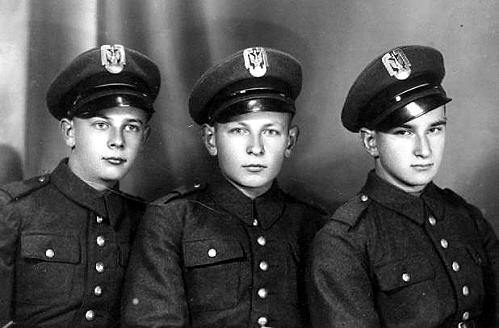
Above: Zbigniew Klatkiewicz aged 18 years with two other cadets.
After a month of recuperation Zbigniew travelled to Scotland to RAF Evanton where he served as a staff pilot, tirelessly flying navigators into the air to train over the featureless mountains and lakes. The airfield was by the seashore of the Cormarty of Firth, 16 miles north of Inverness. From Scotland Zbigniew found himself assigned as staff pilot, instructor and test pilot to RAF Manby, Lincolnshire. RAF Manby was built as an Armament Training School and was responsible for training armament officers, bomb aimers, air gunners and armourers, using a variety of aircraft ranging from Hawker Hinds to Wellingtons.
After the war fewer than 3,000 Poles returned to their homeland. 2,800 emigrated from the UK to other countries of residence, and 500, mostly flying personnel, joined the RAF.
Zbigniew’s parents, Marta and Marcin, didn’t know what had become of their son. He had simply vanished. They had spent many years looking for him with the aid of the Polish Red Cross (Polski Czerwony Krzyż – PCK). Not until 1947 did the family learn that Zbigniew had survived the war and had settled in England.
After a courtship which lasted at least two years, on Christmas Eve 1946 Zbigniew Klatkiewicz proposed to Marjorie Iseton. They were married in the Spring of 1947 in Sedgewick, Durham. Marjorie, born on July 29 1922, was the oldest of two daughters. Before her marriage she had been a typist. Her parents, Thomas and Ethel née Dyke ran a draper’s shop, selling children’s clothing. Her younger sister Constance (born December 3 1923) worked in the shop with them.
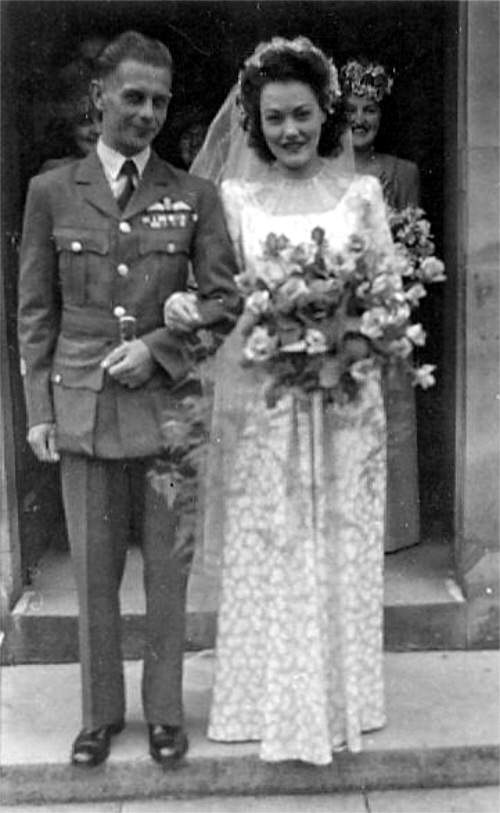
Above: Zbigniew Klatkiewicz’s wedding to Marjorie Iseton in Spring 1947.
In January 1947, Zbigniew finally managed to establish contact with his family in Poland. After all of his previous letters had been “returned to sender”, he almost gave up hope of ever finding them. He was overjoyed to finally be in touch with everyone that everyone was “all right and healthy.” Zbigniew’s parents were still alive then. His father Marcin died in 1950 and his mother Marta in 1961.
In August 1948, Sergeant Pilot Zbigniew Klatkiewicz transferred to the Polish Aerospace Adaptive Corps (PRC) at RAF Hednesford, Staffordshire. He left military service in February 1949.
Zbigniew Klatkiewicz was awarded the Polish Order of the Virtuti Militari which recognises and rewards outstanding military valor above and beyond the call of duty. It is one of the oldest decorations for valor in the world and is equivalent to the US Medal of Honour and the British Victoria Cross. He was also awarded the Polish Cross of Valour (Krzyż Walecznych) which is awarded to one who has demonstrated deeds of valor and courage on the field of battle. He also received: the Air Crew Europe Star, a medal awarded to Commonwealth aircrew who participated in operational flights over Europe from UK bases, between September 3 1939 to June 5 1944 (outbreak of war until the start of the D-Day Normandy Invasion), the 1939-1945 Star and the Defense and War medals.
Also in 1949 Zbigniew and Marjorie had their first son, Bernard who was born in Newcastle. By the summer of 1950 the family had moved to Wakefield where Zbigniew took a job in a bakery. They lived at 19 Duke of York Street, just off Jacob’s Well Lane. Their second son Paul was born in Wakefield in 1954. They then moved to Ossett where they opened a grocery shop at the junction of Dale Street and Church Street. “Klat’s”.
Zbigniew did plan to visit his family in Poland, but he was discouraged by the political situation. It’s certainly no coincidence that he waited until September 1991 to visit his sister in Poznań, with Marjorie and his granddaughter. 1991 saw the first parliamentary elections since the fall of communism and Soviet troops started to leave Poland. All the family were awaiting his arrival in Ostroróg and, as he greeted his sister Jadwiga, Zbigniew who was 69 years old, was overcome with emotion. He hadn’t seen her since he was 17. There was a huge celebration at the Mercure Hotel, after which he then travelled on to the home of his nephew where he greeted his relatives whom he had not seen for over 50 years. He had been there only two hours when he was taken ill and a doctor had to be called. Dr Tadeusz Tanalski diagnosed a heart attack. An ambulance took Zbigniew to the hospital in Szamotuły where he stayed for almost three weeks. However, his broken heart could not be cured.
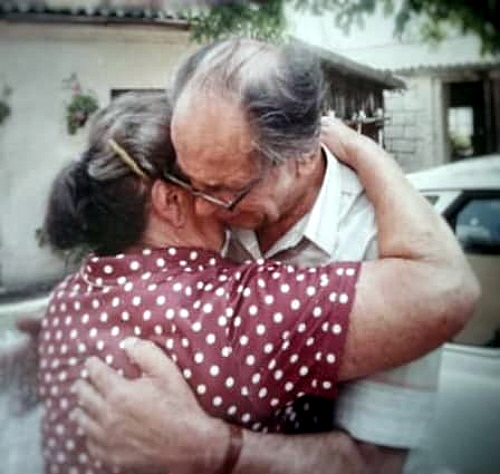
Above: The last picture of Zbigniew Klatkiewicz during a visit to Poland in 1991, here greeting his sister Jadwiga whom he had not seen for over 50 years.
Zbigniew Klatkiewicz died on September 21 1991 in the Szamotuły hospital. Marjorie flew his Zbigniew’s coffin back to England where he was buried at the cemetery in Newark on Trent, Nottinghamshire with other Polish airmen from 300 Squadron. Sadly, the Polish Air Force’s 300 Squadron suffered the highest number of deaths of any Bomber Command unit.
The family in Poland cherish the memory of their uncle and they tell their children about Zbigniew Klatkiewicz, who left his home in Oporów in 1938. And how, in 1991 when Poland was a free state, he returned to his homeland to die among his own people.
References:
http://www.polandinexile.com/bartkowiak.html
https://www.iwm.org.uk/history/the-polish-pilots-who-flew-in-the-battle-of-britain
http://www.iwm.org.uk/collections/item/object/80011870
https://feefhs.org/index.php/resource/poland-virtuti-index-k1
https://rememberourdead.weebly.com/poland.html
http://www.polandinexile.com/escape.html
May 2019
In 1931 a new vicar, the Reverend George H. Marshall was taking up residence at the Holy Trinity vicarage on Dale Street, Ossett. Few in town knew then, or even now, of his connection to Baron Manfred von Richthofen, aka the Red Baron; the Prussian aristocrat who was said to be the deadliest flying ace of World War I.
 On July 15 1889, George Herbert Marshall was born at Old Royd, Heptonstall, situated in the hillside above the Calder Valley, and he was baptised at St James’s Church, Heptonstall on September 17th that same year.
On July 15 1889, George Herbert Marshall was born at Old Royd, Heptonstall, situated in the hillside above the Calder Valley, and he was baptised at St James’s Church, Heptonstall on September 17th that same year.
George was the fourth of five sons born to Richard Marshall and Annie Elizabeth Gomm who had married on Christmas Day 1882. Whilst their sons flourished, Clara, their only daughter, died in 1888 before she reached her first birthday.
In 1892 George’s father moved his family to Bankfoot House, Hebden Bridge, where he set up in business as a corn dealer. As the boys grew older, two of them in particular: George and his youngest brother, Norman attracted the attention of the Reverend Sidney Marshall Smith, who was then the vicar of Hebden Bridge and he encouraged them to enter the ministry.
George matriculated at the University of Manchester and, in 1912; he took his Bachelor of Arts degree. A year later he became a Master of Arts. He studied for Holy Orders at Egerton Hall, a new theological college in Manchester, and in 1913 he became a deacon, licensed to the curacy at Kirkburton, Huddersfield. The following year he qualified as a priest.
During his time at university, George had been recruited by its Officer Training Corps. In the first sixth months or so of WW1 over 20,000 officers and more than 12,000 other ranks were recruited from British universities. On May 13th 1915 George was commissioned as a Chaplain of the Armed Forces with the rank of captain. On July 15th 1915, instead of celebrating his 26th birthday, George embarked on the journey to Gallipoli with the Mediterranean Expeditionary Force. According to the requirements of King’s Regulations, his role was to “conduct the army’s compulsory religious services and bury its dead.
On August 23rd George joined the British 13th (Western) Division. Up to then he had, for the most part, been acting as chaplain to one of the hospital ships, with the Australian troops, and had been in the trenches with them until he was taken ill with enteric and dysentery.
When the troops were evacuated from Gallipoli on January 8th – 9th, 1916, George went with them. He was still attached to the 13th Division and was with them throughout the Mesopotamia campaign. The British Army in Mesopotamia would grow to about 440,000 men with almost three quarters of those who fought from the Indian Army. The 13th Division was sent to relieve Kut al-Amara in Iraq and it was during this journey that George spotted a wounded officer laying out in the open and in obvious imminent danger.
For more than an hour, using an entrenching tool, George worked to build a protective shield over him; all the while in full view of the enemy. A bullet struck the shield but all that George said was: “Not this time Brother Turk”. The officer he was protecting stated that it was a mystery to him how George escaped being hit.
The relief force never reached the British troops at Kut al-Amara who were, by then, starving and desperately running low on ammunition. The British Army did make several attempts to lift the siege but all were unsuccessful and on April 29th 1916, after 147 days, they surrendered to the Turks. At that time, it was the longest siege in British Army history.
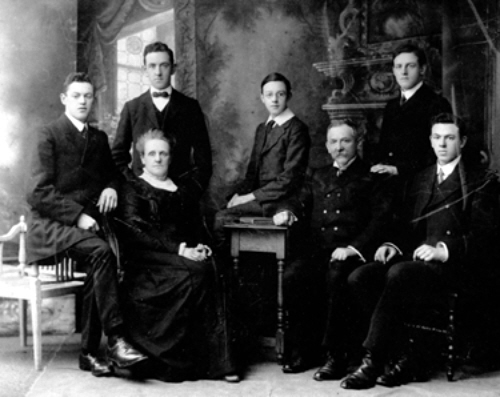 Above: The Marshall family, circa 1910. Left to Right: Amos, mother Elizabeth, William, Norman, father Richard, George, Thomas.
Above: The Marshall family, circa 1910. Left to Right: Amos, mother Elizabeth, William, Norman, father Richard, George, Thomas.
At home in Hebden Bridge, in May 1916 Richard Marshall received a letter from his son George saying that he was in hospital with fever. George had contracted typhoid and was hospitalised in India from where he was subsequently sent home to England.
George then spent time at the Third London General Hospital in Wandsworth. The hospital had been the Royal Victoria Patriotic School but was requisitioned in August 1914 by the War Ministry and the children transferred to local houses nearby. There is no record of George having been the chaplain of this hospital which leads me to deduce that he was there as a patient.
I have to wonder if this is where he first met Irene Carruthers, his future wife, who was by this time a qualified nurse. The medical staff were seconded from the Middlesex Hospital, St Mary’s Hospital and University College Hospital. It is quite possible that Irene could have been among those seconded.
Upon leaving Wandsworth, George took a post as chaplain at the Guards Training Depot at Caterham in Surrey. In the London Gazette of December 22nd 1916 George was “mentioned in despatches” for his heroic actions in Mesopotamia. British commanders-in-chief of a theatre of war or campaign were obliged to report their activities and achievements to the War Office in the form of despatches, which were published in The Gazette.
On April 25th 1917, George was summoned to Buckingham Palace where King George V invested him as a Companion of the Distinguished Service Order. The DSO is awarded for meritorious or distinguished service by officers of the armed forces during wartime, typically in actual combat, serving under fire, and usually awarded to those above the rank of captain.
In October 1917, George was stationed in France, as the chaplain to the GHQ Machine Gun School in Wisques. The British Expeditionary Force had established the school three years earlier to train new regimental officers and machine gunners.
From there George joined the Royal Flying Corps, 101 Squadron at Bertangles as their chaplain. The RFC had formed at Farnborough on July 12th 1917 and it was only two weeks later that it moved to France to operate as a night bomber squadron.
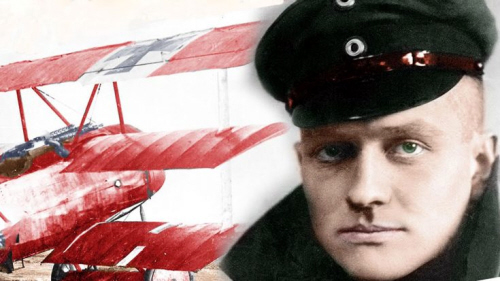
Baron Manfred von Richthofen was born on May 2 1892, into an affluent Prussian family. Growing up in the Silesia region of what is now Poland, he led a life of privilege playing sports, riding horses and hunting wild game. Under the instructions of his father, he was enrolled in military school at the age of eleven. Shortly before he turned 18, he was commissioned as an officer in the German cavalry.
After the outbreak of WWI, the Baron served on both the Eastern and Western Fronts and he was awarded the Iron Cross for his daring trips, carrying messages along the front lines. In 1915, he transferred to the German air corps, initially serving as an observer and later as a pilot. He crashed during his first solo flight, but his determination eventually caught the attention of Germany’s top ace, Oswald Boelcke, who recruited him for a new fighter squadron.
The Baron claimed his first confirmed aerial victory on September 17 1916. Over a period of 17 months he shot down 80 allied aircraft, though some historians believe the unofficial total to be closer to a hundred. He once said, “I never get into an aircraft for fun. I aim first for the head of the pilot, or rather the head of the observer, if there is one.”
The Baron’s victims were members of the Royal Flying Corps, many of whom were boys, often with barely a dozen flying hours under their belts. The RFC was soon known as “the suicide club” because pilots were only in the air for a maximum of 11 days before they were shot down. The Baron said that the English pilots were “dare devils personified and that their intrepidness made them foes to be respected”.
 In January 1917 the Baron was given command of the German squadron Jasta 11. He celebrated the promotion by painting his Albatross biplane red, soon becoming known as The Red Baron. He is reported to have said: “I want them to see me. And I want them to be afraid.” He decorated his walls with the serial numbers of the aircraft he shot down and had a jeweller make him a small silver cup engraved with the date and make of each aircraft. He would eventually acquire sixty cups before a silver shortage eventually put a stop to his commemorative trophies. But the killing continued.
In January 1917 the Baron was given command of the German squadron Jasta 11. He celebrated the promotion by painting his Albatross biplane red, soon becoming known as The Red Baron. He is reported to have said: “I want them to see me. And I want them to be afraid.” He decorated his walls with the serial numbers of the aircraft he shot down and had a jeweller make him a small silver cup engraved with the date and make of each aircraft. He would eventually acquire sixty cups before a silver shortage eventually put a stop to his commemorative trophies. But the killing continued.
The Red Baron was eventually shot down whilst chasing a British fighter pilot. In 1997, almost 80 years after his plane was brought down, it was claimed that British flier Captain Tilden Thompson was the pilot who had deliberately lured the German ace into his final dogfight. By flying a two seater spotter plane low over German lines as a decoy, Captain Thompson is said to have set the trap.
Officially, the death of the Red Baron was credited to Canadian pilot Captain Roy Brown. With an advance in ballistics and forensics, it is now considered by some military historians that the Red Baron was actually killed by an Australian machine gunner, firing from the ground.
Lewis gunners attached to the 3 Squadron Australian Flying Corp were firing at the Red Baron when his machine spun to earth. Although he was shot in the torso the Baron still managed to land his plane but soon died from his wounds.
On April 21 1918, the Allies recovered the body of the Red Baron from a field in Vaux sur Somme, France. Captain George Herbert Marshall was still serving as chaplain to the Royal Flying Corps 101 Squadron at the time that the Red Baron was shot down. He was the closest Anglican chaplain to the scene and, as the Baron was a protestant, George was given the duty of officiating at his burial.
A crowd of soldiers and several townspeople gathered around as a eulogy was given by George, and then the coffin was lowered into the grave. The brass plate on the coffin said that Baron von Richthofen was killed in action and that he was 25 years old. A firing party, made up of Australian forces, fired three volleys and a bugler sounded the last post.
You can see rare film footage that shows Rev George Herbert Marshall walking at the head of the funeral procession and carrying out the service which took place with full military honours by clicking on the picture above.
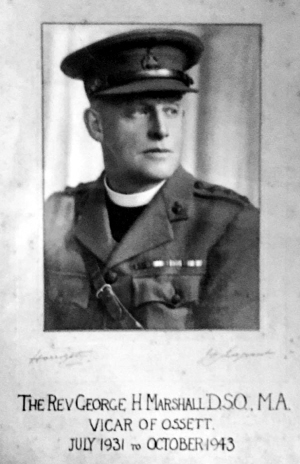 Rev. George Marshall later proceeded to the 18th Division, where he remained during the allied retreat of March 1918 and the subsequent victorious advance. Demobilisation began on December 10 1918 and by March 1919 the division ceased to exist.
Rev. George Marshall later proceeded to the 18th Division, where he remained during the allied retreat of March 1918 and the subsequent victorious advance. Demobilisation began on December 10 1918 and by March 1919 the division ceased to exist.
As well as the DSO, George was awarded the Victory and British Medals and the 1915 Star. After the war, George returned to Kirkburton and to his wife, Irene. At the age of 28, George had married 36 year old Irene at Westminster St James the Less. At the time of their marriage, on February 5 1918, Irene gave her address as 165 Vauxhall Bridge Road, Pimlico, just five minutes from St James’s. Home on leave from the war, George’s address was “Ivy Bank”, Hebden Bridge.
Irene was the daughter of Scotsman, Rev George Thomas Carruthers MA, and his second wife Elizabeth (nee Cartwright). Rev Carruthers had been a senior chaplain in the Bengal Ecclesiastical Establishment and several of Irene’s siblings were born in India. Irene was born in Bury St Edmunds, Suffolk on November 20th 1881.
By the time she was 18, both of her parents had died and Irene, with her sister Mabel and their brother Vincent, had moved to Edinburgh where Vincent was studying medicine. But the three siblings were soon separated when Mabel died in 1908 at the age of 31. In 1909 Vincent married and then joined the Royal Army Medical Corps and went to serve in Ceylon (now Sri Lanka). In 1911 Irene enrolled as a student nurse at the East Suffolk and Ipswich Hospital, Anglesea Road, Ipswich.
In June 1919 Rev George Herbert Marshall MA, DSO became the curate at St Matthew’s, the Anglican Parish Church of Burnley. He and Irene had been there for less than a year when, in early 1920, George was offered the office of the Vicar of Shelley, a church connected to that at Kirkburton. The vacancy arose when Rev Hay, who had been at Shelley Church for twenty years, moved to Gawthorpe.
George was said to have taken a deep interest in the social side of church work and had a strong connection with the Young Men’s Institute. He had also earned the respect of his parishioners and they were sorry to see him move on. He didn’t want them to think that he was keen to leave and explained that the Vicar of Kirkburton and the Bishop of Wakefield were anxious that he should accept the new place at Shelley. George accepted the office and, at Easter that year, he left Lancashire and, with Irene, returned to Yorkshire.
On March 7th 1922, whilst at Shelley, George and Irene’s son was born; they named him George Carruthers Marshall.
George was the Vicar of Shelley for three years, until June 1 1923, when he was inducted as the Vicar of St Augustine’s Church, Pellon, Halifax. Traditional parish life at St Augustine’s was apparently in decline by this time but, with George’s natural enthusiasm and energy and the support of his wife Irene, the church gradually began to regain something of its former prosperity. Almost a decade after he first arrived, the Easter Sunday Service saw the largest congregation it had had for a quarter of a century, which was further testament to George’s determination and tenacity.
Along with his role as Vicar of St Augustine’s, George acted as chaplain to Alderman Robert Thomas who was the Mayor of Halifax in 1923-24. Both men were strong supporters of missionary work and, whilst at St Augustine’s, George was the Chairman of the Halifax Auxiliary of the Church Missionary Society
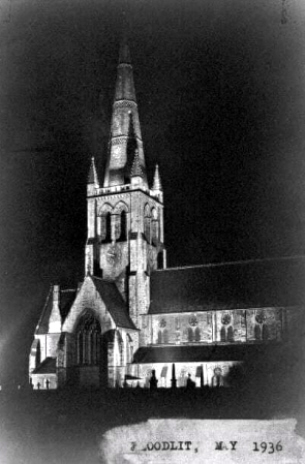 During his time in office at St Augustine’s, George was offered the living at Holy Trinity Church, Ossett but he chose to not accept it. He remained at St Augustine’s for eight years until July 1931 when he was again offered the living at Holy Trinity Church in Ossett. This time George did accept the offer and he moved with Irene, George, and his widowed mother Annie Elizabeth, to the Vicarage on Dale Street.
During his time in office at St Augustine’s, George was offered the living at Holy Trinity Church, Ossett but he chose to not accept it. He remained at St Augustine’s for eight years until July 1931 when he was again offered the living at Holy Trinity Church in Ossett. This time George did accept the offer and he moved with Irene, George, and his widowed mother Annie Elizabeth, to the Vicarage on Dale Street.
Rev. G.H. Marshall is mentioned many times in local newspapers in connection with births, deaths and marriages at Holy Trinity Church. In May 1936, the Rev. G.H. Marshall was mentioned in the Ossett Observer for something entirely different.
Holy Trinity Church was built in 1866 and the total of the construction costs was more than £20,000. Today’s equivalent value is over one and a half million pounds so it’s hardly surprising that 70 years after it was built there was still a deficit of £200 (now just shy of £10,000). A fund was established to raise the £200 needed to pay off the debt.
To raise fund, Rev George Marshall volunteered to sit in the west end of the church for 24 hours between Friday and Saturday midnight and people took or sent their gifts to him. George had to break off during the day to perform two weddings and the congregation at each contributed generously to the fund. In total 580 people contributed to this novel way of raising funds for the church.
Those who donated included many non-church people and many prominent Nonconformists. The first gift of a shilling was received from an unemployed man and the last came by post from Staincliffe. After 22 hours the total stood at £170. Mayor Gladstone Moorhouse, who was also the church warden, arrived with over £25 which he had collected from friends. Shortly afterwards the £200 mark was passed and at midnight the total had reached £225.
With the help of his friends, George had achieved his goal!
George was in the newspaper again in September 1936. This time he was explaining why he believed that the lack of trees in the town was connected to the lack of Ossett weddings almost two decades later. During WW1, Ossett’s many mills had used sulphuric acid in the process of making military uniforms. George explained how the acid which spewed from the mills killed off the trees in Ossett, leaving the town with no “Lover’s Lane” and no leafy parks, turning the town into “a cheerless, romance discouraging waste, in which the marriage bells are virtually silent.” George said that the amount of marriages at Holy Trinity Church in 1936 was almost zero. He was reported as saying that he had been “prodding” the Afforestation department of the Ministry of Agriculture to plant some trees in “the one treeless town in Yorkshire”.
George and Irene left Ossett in 1943. In 2001, his son, George Carruthers Marshall remembered his father telling him: “They (3 Squadron Australian Flying Corp) gave my father a cylinder from von Richthofen’s engine, which he kept in a tin box, wrapped in a sack. When he went back into the Army in WW2 he had to leave his Vicarage, so he donated the cylinder to the War Effort Scrap Drive!!!!”
Steel and iron were in short supply and so 1943 saw the start of a national drive to collect scrap metal. By recycling unused or unwanted metal the government could build ships, aeroplanes and other equipment needed to fight the war. How ironic then that the Red Baron, indirectly, contributed to the building of Allied aeroplanes.
On October 9 1943 George was appointed as Army Chaplain to the Wireless School at Forest Moor near Harrogate. The establishment was part of a network of British signals intelligence collection sites which tracked and intercepted German radio transmissions. This information was so sensitive that it was taken by motorcycle riders directly to Bletchley Park, home of the famous Enigma; the encoder used by the Germans to encrypt secret messages.
George served at Forest Moor until July 5th 1945 when he became the vicar of St Paul’s Church in Alnwick, Northumberland.
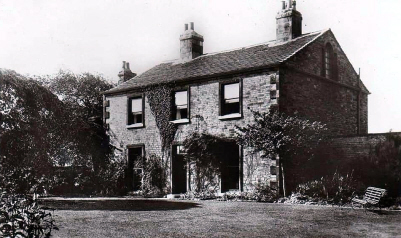 George returned to Ossett, and to Holy Trinity Church, to officiate at the wedding of his son, George Carruthers Marshall, and Ann, the daughter of his old friend Gladstone Moorhouse, on April 21st 1949, which was the 31st anniversary of the death of the Red Baron.
George returned to Ossett, and to Holy Trinity Church, to officiate at the wedding of his son, George Carruthers Marshall, and Ann, the daughter of his old friend Gladstone Moorhouse, on April 21st 1949, which was the 31st anniversary of the death of the Red Baron.
Right: The Vicarage, Dale Street, Ossett.
The Yorkshire Post, dated Friday April 22nd 1949, reported the wedding, saying that the bridegroom had served in the RAF during WW2 and, at the time of his marriage to Ann, was employed on the Duke of Northumberland’s estate where he was engaged in forestry. Perhaps he was inspired by his father?
1949 was a year for celebration, but it was also a year for mourning when, on September 13th, George’s wife, Irene, was found dead on the lawn at St Paul’s Vicarage, Alnwick. At an inquest their son George gave evidence, saying that his mother had carried some carpets to the front lawn to be cleaned with a vacuum cleaner. At first it was thought by a maid that Irene had merely fainted. George went out and found her, lying on her back. She was dead and the cleaner was still running. The pathologist’s report stated that death was due to cerebral haemorrhage.
The last mention in the newspapers of George was a small notice, announcing his death in 1953.
“MARSHALL – January 6, aged 63 years, the Rev George Herbert Marshall, of St Paul’s Vicarage, Alnwick, Northumberland, sometime Vicar of St Augustine’s, Halifax and Holy Trinity, Ossett. Service at St Paul’s Church, Alnwick on Friday at 2pm: interment Alnwick Cemetery 2:30pm”.
Thanks to Margaret Nettleton for this family picture, which shows a family wedding party in 1931 with the Rev. George Marshall seated front left.
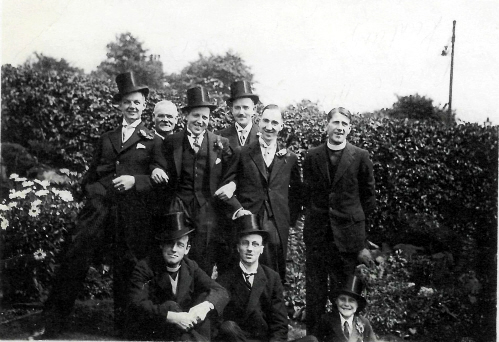
The full story of the Red Baron and the Vicar of Ossett is also available as a PDF doucument in the Downloads section of the web site.
Ossett Architect by Alan Howe
There is scattered knowledge about W.A. Kendall’s architectural achievements in Ossett but the story of this remarkable man’s life has never before been researched. Until now the story of this man who arrived in Ossett aged five years old has remained untold. This is the story of a kind, modest, understated man who led a most extraordinary life.
Until now this is what we didn’t know about the life of W.A.Kendall, Architect and Surveyor.
A nephew awarded the Military Cross in WWI who later co-designed the Ossett War Memorial; a niece who was mentioned in despatches and was the first Ossett woman to serve overseas in The Great War. A widowed father who went away with a lady, an uncle who was an embezzler, two nephews killed in action in The Great War and a great nephew who was awarded the Military Cross in WWII and who was subsequently awarded the M.B.E.
William Arthur Kendall lived in Ossett for 75 of his 80 years. By the age of 24 years in 1881 he was a respected architect with an office on Bank Street. His services and skills were much in demand. In spite of his reputation at that time surprisingly little is known about William Arthur Kendall and those close to him. In the 1880’s and 1890’s he changed the streetscape of the town in which he lived for 75 of his 80 years.
This is his remarkable and unparalleled legacy to Ossett.
Station Road was built in the late 1880’s joining the Market Place to Park Square. In 1894 the Ossett Observer reported “Good stone buildings have arisen along both sides, and such is the impetus given to the adoption of a more ornamental style of architecture in the erection of new business premises that the appearance of the centre of the borough is altogether changed for the better…..”
On 4th February 1919 a war weary Ossett held a public meeting at the Town Hall to discuss how the town might remember its fallen heroes in The Great War 1914-1918. William Arthur Kendall spoke passionately about the need to ensure that whatever was done should be done for the benefit of those who had suffered and their dependants. He proposed that land be acquired on which to erect 50 or 60 cottages in picturesque blocks, as a miniature garden village for the benefit of the victims of the war, with a club room.
Notwithstanding strong support for Mr. Kendall’s proposal a vote was taken and the proposal for a public park with a public building such as a library or art gallery was carried by 45 votes to 34. This was not to be the end of the Kendall family’s connection with the Ossett War Memorial.
William Arthur Kendall was born in Leadenham, Lincolnshire in spring 1857 the eldest son and third child of eight children born to schoolmaster Stephen H. Kendall (1830-?) and his wife Emma (nee North) who married at Leeds Minster and Parish Church of Saint Peter-at-Leeds in August 1853. Stephen Kendall rarely used his middle name, whereas his brother was known by most as William Holliday Kendall (1838- 1913), both schoolmasters, and the only sons of schoolmaster William Kendall (1804-1891) and his wife, Ann (nee Holliday).
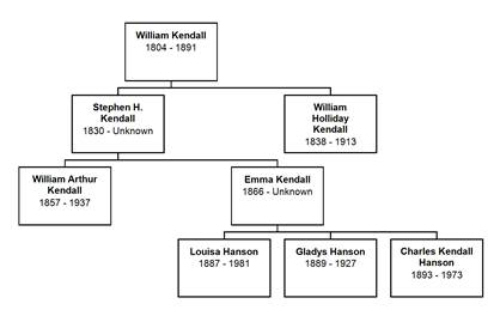
William Arthur Kendall’s father, schoolmaster Stephen, lived something of an itinerant existence flitting from school to school. In 1851 he was Tutor at Bridlington Parsonage. Married in August 1853, their first child, Clara Ann was born in Tadcaster in 1854 and was baptised there in October 1854. In summer 1855 the couple’s second child, Agnes Louisa, was born in Luddenden where he was master of the National school. Sadly their first child, Clara Ann, died and was buried there in November 1856. By spring 1857 the couple had moved to Leadenham, Lincolnshire where William Arthur was born. Stephen was both post master and schoolmaster there and working alongside his wife who was school mistress. He earned £20 a year to teach 20 poor children.
The couple and their two surviving young children were soon on the move again and on 18 July 1858 William Arthur Kendall was baptised at Tadcaster where Stephen’s father, William, had been a schoolmaster for at least ten years. By early April 1861 Stephen had taken a position of schoolmaster at York Walmgate whilst his father, William was living with his wife and their grand daughter, Agnes Louisa at Chapel Street Tadcaster. 1861 was an interesting year for the Kendall family. Stephen applied to join the local police force at Tadcaster and was admitted on 11 April. He resigned twelve days later. We learned that he was 31 years and 10 months old, 5’8 inches tall with a fresh complexion, grey eyes and black hair. In spring 1862 Stephen Kendall, his wife Emma and their four children, aged seven years or under, made their way to Ossett and a new home at Little Townend. Stephen took up a position at Ossett Free (Grammar) School and subsequently became Headmaster. His tenure was not to be without controversy. By 1871 at Little Townend the couple had three more children who were born in Ossett between summer 1863 and 1866.The family was complete.
By 1866, Stephen’s brother, William Holliday Kendall had journeyed with his father, William, to Horbury. Both men were schoolmasters living in adjacent homes on Old School Road, Horbury. In December 1869 William Holliday Kendall married widow Amelia Elizabeth Earle in Lambeth and two years later they were living on Old School Road Horbury. His father and mother were living next door; both men were schoolmasters. The extended family was complete and local. What possibly could go wrong?
In 1880 almost 20 years after Stephen and his family arrived in Ossett they were living at the Master’s house, Ossett Old Grammar School in the Market Place, adjacent to Dale Street. Tragedy struck in early February 1880 when William Arthur’s mother, Emma, died aged 55 years. His 21 year old brother, Walter Augustin, died six weeks later in mid March 1880. Mother and son were buried at Holy Trinity Church. A year later William Arthur, by this time 24 years of age and an Architect, was living with three of his sisters and their widowed father, Stephen aged 50 years. Worse was to come.
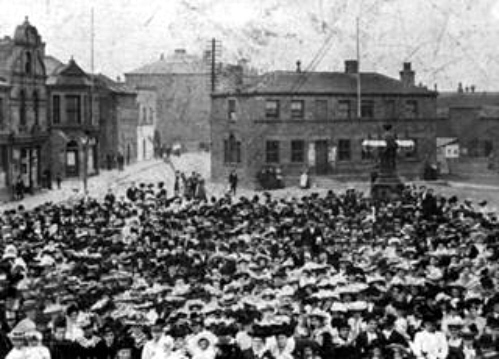
Above: Ossett Free School (aka Old Grammar School)in the Market Place
By early 1881 Stephen’s brother William Holliday Kendall, eight years his junior had worked in Horbury as assistant overseer, schoolmaster, collector to the Local Board, surveyor and inspector of nuisances. In March and April 1881 he was examined, tried and, on 6th May 1881, convicted of defrauding the Lancashire and Yorkshire Railway Company of £158 11s on two occasions in November and December 1876. This is equivalent in current (2020) values to almost £37,000. He pleaded guilty and was sentenced to six months imprisonment with hard labour which he served at Wakefield and Leeds HMP.
In a sign of those times His Lordship summed up at the trial revealing that he had the greatest reluctance to class with common prisoners a man in the position of the prisoner …… Two men who were tried on the same day as William Holliday Kendall was sentenced to six months for stealing £37,000 were each sentenced to 12 months. One man had stolen four shirts. The other man had stolen two geese. Sauce for the goose was plainly not sauce for the gander.
What of Stephen Kendall? It’s fair to suppose that the events of 1880, when he lost his wife and a child, would have caused Stephen and his children not a little torment. The imprisonment of his brother in 1881 and the shame to him and the repercussions for headteacher Stephen and his family may have been too much. William Arthur Kendall also had architectural contracts in place or pending and Victorian Ossett and Horbury might consider there was more than one bad apple in the Kendall barrel. Worse was to come.
On 1st June 1881 the Police Gazette issued the following notice seeking the whereabouts of Stephen Kendall, Master, Ossett Grammar School.
Wanted, on warrant, for embezzlement:- STEPHEN H. KENDALL, 50 years of age, 5 feet 8 inches high, dark complexion, dark brown hair and whiskers, turning grey, very stout, of drunken habits, and fond of low company: dressed in dark grey suit, and high hat; a schoolmaster, good address, and last residence Ossett Grammar School. Information to Mr. Supt., Airton, Dewsbury, Yorkshire – Bow-street,May 30.
On 12 November 1881 the Batley Reporter and Guardian reported;-
THE SCHOOLMASTER ABROAD. – on Thursday, at the Dewsbury County Court, Mr. Burton, solicitor, made an application on behalf of the Wakefield and Barnsley Banking Company, that the service at the house of Stephen Kendall, schoolmaster, Ossett, might be declared sufficient, personal services being impossible on account of his continued absence. He said that Kendall had left household furniture to the value of about £100, besides shares in a building society.- The Judge asked if Kendall was keeping out of the way to avoid service?- Mr. Burton replied that he could not say so, he had gone away with a lady, and there was reason to believe he would not return.- The Judge observed that he could not grant the application under the circumstances.
In 1881 Mr.Thomas Burton, solicitor and Stephen Kendall , schoolmaster, were near neighbours on Dale Street. At that time Mr. Burton was also the clerk to the Ossett Local Board.
So it seems that Ossett and Stephen Kendall had parted company for good. Stephen would forfeit reputation and his position as Master of Ossett Grammar School. I suppose we shall never know if he left with the best wishes of the family he left behind, but there is little doubt that his six surviving children, including William Arthur Kendall, would be left to pick up the pieces.
This was 1881 and a scandal of immense proportions at a time when William Arthur was embarking on a career as an architect. His first commission, the design of Ossett Conservative Club came to fruition when it was built in this year. His next Ossett architectural commission was a long seven years hence when the Ossett Temperance Hall was opened on Illingworth Street in 1888.
Ossett was a small community and this would surely have been the talk of the town. Anyone who had or knew a child in secondary education would know, or speak of the circumstances. Even the main characters in the unravelling story were known to each other.
Five years earlier the Wakefield Coroner, Mr. Thomas Taylor held an Inquest at The Fleece Inn, Spa Street, Ossett on Wednesday 26 July 1876. The Inquest was to hear into the death by shooting of a local man, John Gosney, from Spring End. Mr. Thomas Burton, solicitor, watched the proceedings on behalf of Joseph Lightowler who was being held in custody having been apprehended on suspicion of murder. Superintendent Airton was also present on behalf of the police. Stephen Kendall was the
foreman of the jury who, after four hours deliberation returned a verdict that John Gosney had been accidentally shot. Two days later at Dewsbury Courthouse it was determined that, in view of the Inquest, no further evidence would be offered and Joseph Lightowler went free.
As fate would have it three years later in November 1879 Joseph Lightowler of Haggs Hill died in Clayton Hospital following an underground fall of coal at Roundwood Colliery. Mr. Thomas Taylor was the Coroner. Devine Retribution or plain misfortune?
In early 1888 his married sister, Agnes Louisa Kendall, died aged 33 years. She was a mother of four young children including their youngest who was named after his uncle William Arthur. On 3 October 1888 he married Margaret Emma Wilkinson at the village of Rostherne, Cheshire and they moved into their first home together at Ryecroft Street, Ossett.
In the same year the Temperance Hall on Illingworth Street, designed by W.A. Kendall was opened. It was described by the Ossett Observer as “in the 17th Century style modernised”. By 1893 the recently wed Kendalls had moved to Ossett Town End which was, at least, closer to his Bank Street office. The period 1890-1894 was his most prolific and brought five significant public building design projects for William Arthur.
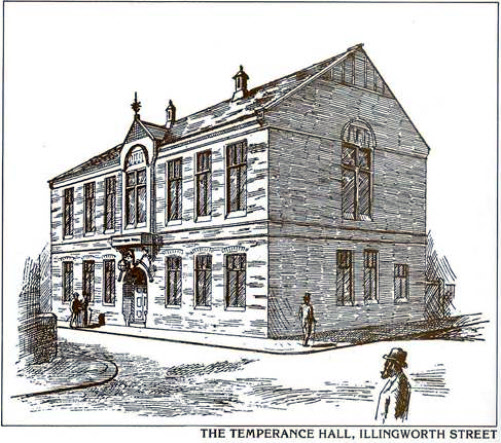
Picture above courtesy: Cockburn’s Almanac 1880’s & 1890’s published by Ossett & District Historical Society 1987.
In spring 1887 his youngest sister Emma Kendall, born and baptised in Ossett in 1866, had married William Brotherton Hanson in Bradford. The couple had three children, Louisa (born 1887), Gladys (1889) and Charles Hanson (1893) who were all born in Bradford. In 1901 William Brotherton Hanson was a boarder in a Bradford boarding house whilst his wife Emma and daughter Gladys were living at the newly built home of her brother at no. 1 The Gables, Station Road. Emma’s other children were elsewhere but joined their mother later. After 1901 no further record of William Brotherton Hanson’s whereabouts has been found. Emma, having been deserted by her father when she was 15 years old was now abandoned by her husband.
From that time, maybe earlier, William Arthur Kendall stepped in, gave sister Emma and his nieces and nephew a home and became a father figure for the children. They were to repay his kindness handsomely. Sadly William Arthur lost his wife of 10 years, Margaret Emma in summer 1898. She was 39 years of age. The couple had no children. It is unlikely that she ever lived at the which William Arthur was building for her at The Gables, a terrace of six dwellings which was built in 1898/1899.Perhaps because of his wife’s passing it appears that William Arthur remained at his Town end home until 1900 when he moved to live at no 1 The Gables. He was not alone as he was joined there by Emma and her children.
William Arthur Kendall was 41 years of age in 1898 and yet his relatively short life had been full of sadness, some joy and huge achievement. In less than 20 years he had lost both of his parents ,his mother by death, his disgraced father and a brother in law by desertion, a shamed uncle had been jailed and a sister, a brother and a wife had been snatched away much too young. He overcame adversity and his eloquence, determination and vision had built a reputation for designing the finest of buildings which gave Ossett a more ornamental style of architecture and took the town to a level of excellence and sophistication which was unimaginable just 10 years earlier.
Excepting Southdale School (opened in 1908), the building of The Gables, a terrace of six dwellings, including the one in which he lived from 1900 was, perhaps fittingly, to be his last major building enterprise in Ossett.
Meanwhile what was happening to the Horbury branch of the Kendall family, William Holliday Kendall and patriarch William Kendall, William Arthur’s uncle and grandfather? In 1881 schoolmaster William Holliday Kendall was imprisoned for 6 months for embezzlement. Whilst he was in Leeds and Wakefield HMP, his wife of 12 years, Amelia Elizabeth (nee Earle), was living alone at no. 1 Westfield Villas. His father, William, by now a widower aged 74, but still described as a schoolmaster, was living at Tithe Barn Road with his 23 year old, London born grandson, William E. Kendall who was a station master. By 1883 the family had moved to Barnsley.
Sadly Amelia Kendall died there in 1883 and widower William Holliday Kendall, an insurance agent, married his second wife, Kate Chesterman in January 1885 at Leeds Parish Church. William Arthur Kendall was a witness for his uncle. By 1891 the couple had two sons and were living at Cemetery Road, Barnsley with William Holliday Kendall’s octogenarian father, William, who died there in spring 1891.
1911 – 1928 A niece and three nephews go off to war. Charles Kendall Hanson M.C., changes his name, co – designs The Ossett War Memorial & marries the widow of a soldier killed in action in WWI who was awarded an M.C. (Military Cross)
In 1911 William Arthur’s uncle, William Holliday Kendall, an assurance agent, was still living on Cemetery Road Barnsley with his wife and two sons who were both working as assurance collectors. He died in Barnsley in 1913 aged 71 years.
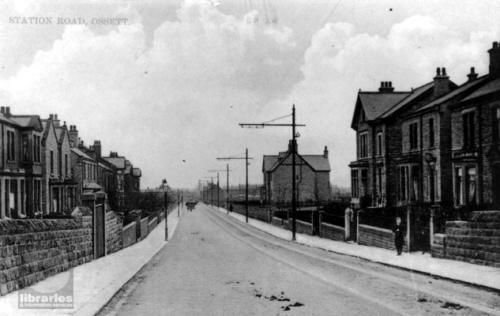
Above: Station Road Ossett about 1925 The Gables terrace on far left. (Courtesy WMDC Libraries)
Back in Ossett in 1911 William Arthur Kendall’s sister Emma Hanson describing herself as married was living at The Gables, Station Road with her son Charles Kendall Hanson aged 17, an architectural student and her 22 year old daughter Gladys who was an elementary school teacher. Emma’s daughter, Louisa was elsewhere possibly working or training as a nurse.
In the same year Architect/Surveyor William Arthur Kendall was visiting the Denby Dale home of his brother in law, Fred Lilley Cook, the husband of Eleanor Beatrice (nee Wilkinson) who was the sister of William Arthur Kendall’s late wife who died in 1898. Fred and Eleanor’s two sons were in the 1911 household; Frank Eaden Cook aged 20 years and John (Jack) Eaden Cook aged 19 years. These two lads were William Arthur’s nephews by marriage. Remember the names.
In 1914 war was declared and on the 16th February 1917, 2nd Lieutenant Charles Kendall Hanson embarked for France with the Sherwood Foresters (Nottinghamshire & Derbyshire Regiment). On 18th March 1918 it was reported that “he had been awarded the Military Cross For conspicuous gallantry and devotion to duty in training his men and leading them in a raid.”
He became one of only two Ossett men known to have been awarded the Military Cross for gallantry. Charles Kendall Hanson returned to his home in Ossett; a hero.
Nurse Louisa Hanson (1887-1981) was Charles Kendall Hanson’s sister and William Arthur Kendall’s niece. Like her mother, brother and sister, Gladys, she was abandoned by her father sometime between 1893 and 1901. Louisa looked upon William Arthur as a father figure. She is believed to be the first Ossett woman to serve overseas in The Great War 1914-1918. On 24th December 1914 the “Ossett Observer” published “Our Roll of Honour List of Ossett and Horbury men who are serving their country.” Despite the headline referring to the men serving their country, the listing includes the name of one woman; Nurse Louisa Hanson, The Gables, Station Road; Red Cross Society in France. In June 1918, she was awarded The Royal Red Cross, 2nd Class and was subsequently decorated by the King at a Buckingham Palace Investiture on 25th June 1920. Her Medal Card records that she was also Mentioned in Despatches.
Lieutenant Frank Eaden Cook (1890-1918) who we met at Denby Dale in 1911 enlisted as a Private on 1st September 1914 just three weeks after war was declared. He rose through the ranks of the 1/10 battalion Manchester Regiment and was made full Lieutenant in April 1918. He was awarded the Military Cross on 30 August 1918 which was bestowed on him on 7 October 1918. He was killed in action two weeks later on 20 October 1918, aged 28 years. Frank Eaden Cook had married Nora Richardson in January 1918. A son, Frank Wilkinson Cook was born a year later. Father and son would never meet. Both were victims of war. Feel their pain.
https://huddersfield.exposed/wiki/Frank_Eaden_Cook_(1890-1918)
Frank’s younger brother, John (Jack) Eaden Cook (1891-1916) enlisted with his elder brother on 1st September 1914.What did their parents, William Arthur Kendall’s in laws, make of that day? Jack joined the 20th battalion Royal Fusiliers and was killed in action on the Somme on 20 July 1916. He was 24 years of age. He is remembered on The Thiepval Memorial with another 72,336 soldiers who have no known grave.
https://huddersfield.exposed/wiki/John_Eadon_Cook_(1891-1916)
All families suffer in war. Some families suffer more than others.
On the 27th October 1921, at Ossett Holy Trinity Church, Louisa married Thomas Allan Robertshaw, from Bradford. Rather fittingly the man who had been responsible for caring for her for most of her life, her Uncle William Arthur Kendall, signed the Register as her witness. Her birth father was not present.
Just days after the Armistice was signed on 11 November 1918 a war weary Ossett held a public meeting to discuss how the Ossett Fallen might be remembered. Less than 20 people attended. A second public meeting was held at the Town Hall on 4th February 1919 to discuss how the town might remember its fallen heroes in The Great War 1914-1918. Several speakers outlined their ideas and more than 120 people attended this meeting.
William Arthur Kendall spoke passionately about his proposal saying that Ossett should ensure that whatever was done should be done for the benefit of those who had suffered and their dependants. He proposed that land be acquired on which to erect 50 or 60 cottages in picturesque blocks, as a miniature garden village for the benefit of the victims of the war, with a club room.
Notwithstanding strong support for Mr. Kendall’s proposal a vote was taken and the proposal for a public park with a public building such as a library or art gallery was carried by 45 votes to 34. A committee was formed and nine years later the Ossett War Memorial was unveiled on the newly built Kingsway.
After the war, Charles Hanson, influenced so much by his architect & surveyor Uncle William, qualified as an architect and became an Associate of the Royal Institute of British Architects (A.R.I.B.A.). In May 1921 Charles renounced and abandoned his birth name Hanson and was thereafter known as Charles Kendall. Charles would have been familiar with his Uncle’s passion that Ossett remember its Fallen. In March 1925 the Borough and its committee had met, debated and proposed that Ossett should have a Cenotaph. A competition was held to encourage design proposals and further particulars were to be available from the Borough Surveyor.
It is not known whether Charles sought further particulars from the Borough Surveyor but a fruitful partnership developed between the two men. Shortly thereafter the Ossett War Memorial was designed and supervised by the said Borough Surveyor, Mr. H. Holmes, M.Inst.C.E.I. and Mr. Charles Kendall M.C., A.R.I.B.A. (Architect) who were the Joint Architects for the project.
On 5 January 1926 at Woodhouse Church Huddersfield Charles Kendall M.C., of The Gables, Ossett married Nora Cook, the widow of Lieutenant Frank Eadon Cook M.C., and the daughter of J.Hamilton Richardson of Huddersfield.
By 11 November 1928 the Ossett War Memorial was in place on the newly constructed Kingsway in readiness for the Address and Unveiling of the Memorial by the Right Honourable Lord Viscount Lascelles K.G., D.S.O.
What a day that must have been for the Kendall family having overcome so much adversity in their lives. How proud they must have been. Fittingly Charles Kendall, an Ossett war hero who had been awarded the Military Cross for gallantry, the nephew of William Arthur Kendall who had done so much for Ossett, was also the co-designer of The Ossett War Memorial. Ossett would look and see what he had made and William Arthur would be reassured that his legacy to Ossett would be in the safe hands of his nephew.
1928 – 1972 Charles Kendall makes a new home; William Arthur Kendall passes away, World War II is declared and Charles Kendall’s stepson is awarded the Military Cross and the M.B.E.
In September 1936, Charles Kendall purchased 22 yards of frontage on to Southdale Road, from the Greenwood family of Sowood House, and designed and built a house, Southdale Croft, between Lime Street and Southdale Road. His new home was only one dwelling away from Green Mount the former home of Hannah Pickard. Her 1891 Will required her Executors to erect a drinking fountain and water trough in the Market Place as a memorial of the 1890 Incorporation of Ossett and the donor.
The fountain was designed by Charles Kendall’s beloved uncle William Arthur Kendall who had this to say about Hannah Pickard in 1893; “A nobler woman than Miss Pickard had never lived and had she lived longer she would have been a yet greater blessing to the poor of the borough”. He added that “he hoped that her example might do something to spur others who were quite as able but not so willing”.
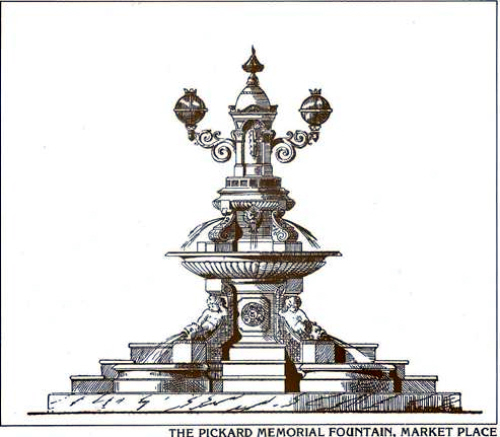
Link below: Miss Hannah Pickard’s biography which provided the basis of the presentation to the Ossett Civic Trust to consider the approval of a Blue Plaque.
In February 1937 Alice Greenwood, the owner of the GP’s Surgery at Sowood House on The Green commissioned Ossett architect and surveyor, Charles Kendall A.R.I.B.A. of 10, Bank Street, Ossett to undertake a survey of Sowood House and to make recommendations regarding any necessary remedial work which may be needed to secure its future. At that time Sowood House was the GP’s Practice tenanted and run by Dr. Rene Wood who had also been awarded the Military Cross (M.C.) in WWI. He and Charles Kendall are the only two Ossett men known to have been awarded the Military Cross in The Great War.
Later that year on 27 December 1937 William Arthur Kendall passed away at his home at no.1 The Gables, the terrace he had designed and supervised the building of in 1898/99. He was 80 years of age. He was cremated at Lawnswood Cemetery Leeds on Thursday 30th December 1937.
He insisted that there be “No flowers. No mourning. By request.” He was understated to the very end of his life.. His effects were £6760 (equivalent to £464,000 current value).
His unremarkable and typically understated obituary from the Yorkshire Post & Leeds Intelligencer (29 December 1937) read as follows;
Mr William Arthur Kendall architect died at Ossett yesterday aged 80. The son of a former head master of Ossett Grammar School he practised as an architect for many years, and was responsible for the plans of numerous public schools and factories. He was past president of the Wakefield Paxton Society and a member of the Yorkshire Archaeological Society, the Wakefield Historical Society, the Wakefield Naturalists’ Society and the Yorkshire Tykes.
Charles Kendall and his wife, Nora, were living at Southdale Croft by 1939 and on 6 July 1948, Mrs. Charles Kendall of Southdale Croft Ossett was proud to announce the engagement of her son, Frank Wilkinson Cook M.C., to Edna Mary Braithwaite.
In case you missed it Mrs Charles Kendall’s late husband, her present husband and her son had each been awarded the Military Cross for gallantry. Her son and Charles Kendall’s stepson,Frank Wilkinson Cook, M.B.E., M.C., a career soldier, was awarded the Military Cross in June 1943 (North Africa Tunisia/Algeria) whilst an Acting Captain with 2/4 KOYLI. In 1957 (Cyprus) whilst a Major with KOYLI he was recommended for a second M.C., but the recommendation was amended to an award of an M.B.E. In 1972 he was appointed Deputy Colonel, The Light Infantry (Yorkshire).Charles Kendall M.C., of Southdale Croft, 18 Southdale Road, passed away on 17th April 1973, aged 80 years. His effects were £40190 (£490,000 at current values). His wife Nora passed away in late 1978.
This has been the story of the extraordinary life and work of a remarkable man, William Arthur Kendall (1857-1937) who in the late 19th Century changed the streetscape of Ossett. His story as told here has touched the many moments in his life when he would be left low.
He overcame adversity and his eloquence, determination and vision built a reputation for designing the finest of buildings which took Ossett to a level of excellence and sophistication which was unimaginable just 10 years earlier. Ossett approved and was as effusive as any West Riding town could summon.
In 1894 the Ossett Observer reported “Good stone buildings have arisen along both sides (of Station Road), and such is the impetus given to the adoption of a more ornamental style of architecture in the erection of new business premises that the appearance of the centre of the borough is altogether changed for the better…..”
In truth Ossett knew very little about William Arthur Kendall. Now we know him much better. Thank you.
Phillip Mickman was a young man with perseverance and determination. Too young to serve in WWII he was just 18 years of age in 1949 when he put post war Ossett on the map and hit the front pages of the local, national and international press.
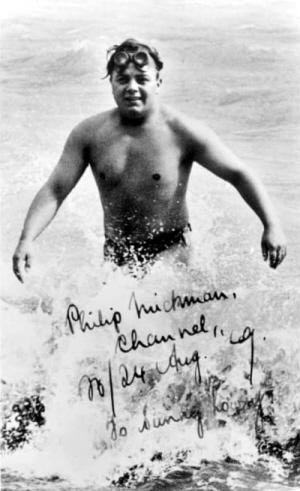 Phillip made history when in that year he became the youngest swimmer to swim the English Channel. He did his National Service in the RAF and in 1952 he did the double and swam the Channel in the opposite direction thereby creating another first.
Phillip made history when in that year he became the youngest swimmer to swim the English Channel. He did his National Service in the RAF and in 1952 he did the double and swam the Channel in the opposite direction thereby creating another first.
Back at home in Ossett a crowd of about 20,000 people shook off the rigour of post war rations and turned out in Ossett Market Place to welcome home Ossett’s young hero who had boosted the town’s reputation and morale.
In 1952 at the age of twenty-one, Mickman became the youngest swimmer to have “done the double” by swimming the Channel in both directions. In 1949 he swam from Cap Gris Nez, Calais to Kingsdown, Deal and in 1952 from St. Margaret’s Bay, Dover to Cap Blanc Nez, Calais.
Seventeen year old Phillip’s first attempt, in the summer of 1948, to swim the Channel was thwarted by wind, rain and tides, which forced him 19 miles off course in the normally 21 mile swim. After 12 hours he was pulled from the water.
Not to be deterred and determined to be fit for the worst of conditions, he embarked upon a gruelling programme of winter training which included trials at Healey dam.

He tried again in July 1949 but swimming into a strong wind, he was pulled out after 13 hours at sea. On August 4th, 1949, Phillip tried for the third time and accomplished the second longest Channel swim in history – in 23 hours and 48 minutes, making him at that time, the youngest swimmer ever to swim the Channel.
On his return to Ossett, Phillip received a huge civic welcome. A crowd of almost 20,000 were in attendance in the decorated Town Hall Square as Phillip was presented with gifts and a commemorative scroll by Mayor Samuel E. Bickle. Amongst the hundreds of congratulatory messages was one sent on behalf of King George VI from Balmoral Castle. This was the biggest day of celebration for a schoolboy in British history.
Ossett’s Postmaster, Mr G.H. Haikings said that, as soon as the news of Phillip’s achievement was broadcast, the Ossett Telephone Exchange was inundated with calls from all over the country. Phillip’s father, Mr W.H. Mickman was also flooded with calls at his hosiery factory on Dale Street.
After a spell in the RAF (National Service) Phillip returned to Dover to complete his ambition of completing the return journey by swimming from England to France. In 1952 he was successful with a time of 18 hours 44 minutes. This made Phillip the youngest person (then) to swim the Channel in both directions.
Phillip William George Mickman was born on 13th April 1931 in Hull, the son of William Henry Mickman who married Gladys Patricia May Peek in Scarborough on 12th March 1928. Their only other children appear to be twins Alan Donald Mickman and Mavis Alison Mickman, born Dewsbury Registration District in May 1933.
Margaret Ann Mickman (neé George), the grandmother of Phillip was the founder of Mickman’s Hosiery. The company started in Scarborough, but they moved to Ossett in 1930. Margaret was born in Kentish Town, London in April 1870 and in 1897 she married James William Mickman. Margaret was James’s second wife. The couple had nine children, including four sets of twins born between 1900 and 1904. Phillip’s father William was the eldest child.
Margaret Mickman eventually returned to Scarborough and she died there on 17th April 1956. Probate was given to her sons: William Henry Mickman (Company Director) and Charles Harold Mickman (Works Manager). Her effects totalled £20,222.
In the 1911 census, Greenland Villa was a single house occupied by mungo manufacturer Allen Mitchell and his family. By 1939, the eight roomed house had been converted into two separate dwellings, which were then known as “Greenland Villa” and “Greenlands”. The Mickman family lived at Greenland Villa.
Phillip’s father William was a Hosiery Manufacturer, born in 1898 and his wife Gladys was born in 1901. In the household were Alexander Peek, working as a Braiding Machinist (Hosiery) and born 1876 with his wife May L. Peek born 1874, presumably Phillip’s maternal grandparents. Also living nearby in 1939 at Gordon Avenue, Dale Street was Phillip’s aunt Barbara Mickman.

Above: Gladstone Moorhouse and Phillip Mickman at East Cliff, Dover. Above Right: Phillip Mickman and Mayor S.E. Bickle at Ossett Town Hall.
Above Left: The letter from George VI to Phillip Mickman offering “warmest congratulations on your successful Channel swim”. Above Right: Workers at the family hosiery factory at Ings Mill, Dale Street.
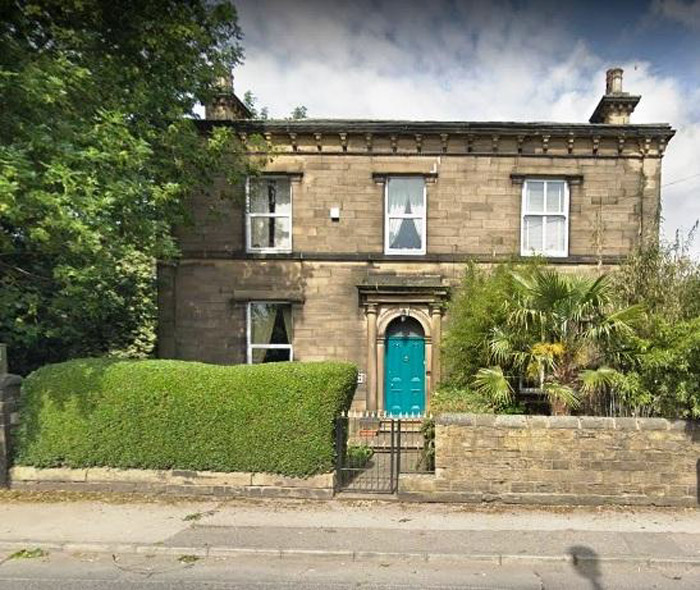
Greenland Villa, Dale Street. Once home to the Mickman family. Photo Alan Howe.
Phillip Mickman died aged 64 years in January 1996 at 8, North Leas Avenue, Scarborough.
References:
On the eve of 2017 a chance discovery led to the hitherto unknown Ossett father and son ministers of religion, the Reverend Thomas Taylor and his son Reverend Thomas Rawson Taylor.
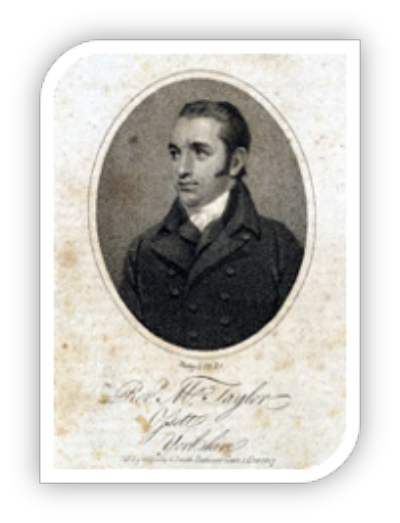
Ossett Heritage supporter Andrea Hartley shared a portrait which carried the title “Reverend Mr. Taylor of Ossett” which was etched in 1807, a mere 210 years ago. Nothing else was known, except that the portrait was now resting in the Digital Collection of The New York Public Library (NYPL). Home to this portrait of Ossett’s Reverend Taylor is now 5th Avenue and 42nd Street in New York City. Just a short 7 minute walk from the Empire State building and 15 minutes from Trump Tower. Who would have thought it, a piece of Ossett in a far-away land.
Her appetite whetted by her find Andrea then discovered a portrait of Thomas Rawson Taylor (1807-1835) and a volume about his life. This was discovered in the Princeton Theological Seminary Library, Princeton University, New Jersey, USA. Nothing else was known.
Thomas Rawson Taylor was born in Ossett in 1807, the eldest son of Ossett Minister Reverend Thomas Taylor of Ossett and like his father he was to become a minister in the church. Princeton University is 50 miles from Fifth Avenue, New York City. Portraits of father and son may be in a foreign land, but they are located barely 50 miles apart.
How did father and son Taylor get to the USA and who were they? Well, the two of them never travelled to the United States of America. Their portraits are there because they were parts of art collections donated in the 20th Century to these Libraries at different times, by different collectors,
Who were they? The father, Reverend Thomas Taylor (1766-1853) was the minister at Ossett Green Independent Congregational Church between 1795 and 1808. He baptised 575 children here including his son, Thomas Rawson Taylor (1807-1835).
The Independent Congregational Chapel Ossett Green, was built following the raising of subscriptions in 1732-1733. Before then Mr Richard Foster set aside part of his pressing shop for Mr. Thomas Dickenson to preach. Early Chapel members were described as “thoughtful hard headed men in whom the emotional was not so strongly developed as the intellectual”
The first chapel was said to be a basic barn like structure with stabling for the horses of the many members who travelled some distance to worship. In 1883 the third chapel to be built on the same site was opened and the last service was held there on Easter Sunday 1973. This building has now been demolished replaced by housing.
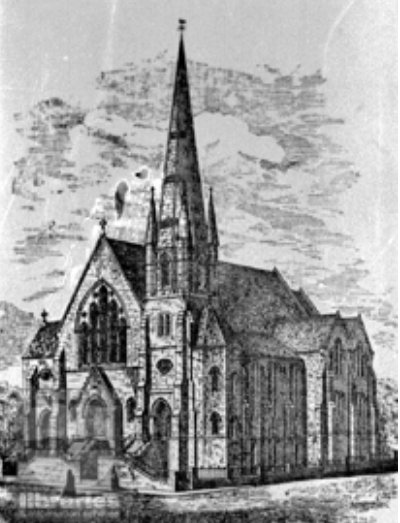 Opposite: The third Ossett Green Chapel built 1883.
Opposite: The third Ossett Green Chapel built 1883.
In 1808, after 13 years of ministering in Ossett Thomas Taylor moved with his wife, Mary (nee Rawson), and his eldest son, Thomas Rawson Taylor, to Horton Lane Chapel, Bradford where he remained as minister until 1835. Thomas and Mary had six more children, three sons and three daughters. His wife and at least three of his children pre-deceased him and he died at Bradford in October 1853, aged 86 years. He was much respected by his congregation and by all denominations.
The son, Thomas Rawson Taylor, was born in Ossett on 9th May 1807 and baptised at Ossett Green Independent Congregational Church on the 25th May 1807. He was educated at Bradford Grammar School and later at Manchester and Airedale. At the age of 23 years Taylor became pastor of Howard Street Congregational Church, Sheffield, where he was based between July 1830 and May 1831.
Sadly he was already seriously ill with consumption (tuberculosis), a disease which had by this time claimed the lives of his brother and sister in their teenage years. He was advised by his medics to cease his preaching but continued to support his father at his Bradford Congregational Church.
At a little before 5 o’clock in the afternoon of Saturday 7th March 1835 Thomas Rawson Taylor fell asleep. Just before 10 o’clock in the evening he died. He was 27 years of age. An obituary of Thomas Rawson Taylor appeared in the Bradford Observer and on the following day, Friday, 13th March 1835 he was buried in the family vault in Horton Street Burial Ground, Bradford.
Thomas Rawson Taylor had left Ossett about the time of his first birthday in May 1808 but he fondly remembered the town.
In a letter dated October 1827 he recalls “I was born at Ossett near Wakefield and am still called by a host of linty clothiers their “awn barn””
On 14th February 1828 he wrote
“……. It is past midnight, and Friday. To-morrow I have to walk through the snow to Ossett, seventeen miles. This Ossett is the place where I was born and which I have never visited since about my eighth or ninth year…..”
Even though his life was tragically short he left a legacy in the form his sermons, poems and hymns. He is most remembered for his words in “I’m but a stranger here (Heaven is my Home)” said to have been written towards the end of his life.
And here is another twist. Many years after Thomas Rawson Taylor’s death his words were set to music by Sir Arthur Seymour Sullivan. He was not only one half of Gilbert and Sullivan but also the composer of the music to “Onward Christian Soldiers” by one time Horbury Bridge curate, Sabine Baring Gould (1834-1924).
The New York Public Library subsequently requested a copy of the detailed research into the life of the Reverend Thomas Taylor and his son for their shelves. This detailed research by Andrea Hartley and Alan Howe can be viewed at the Ossett Heritage Downloads Page
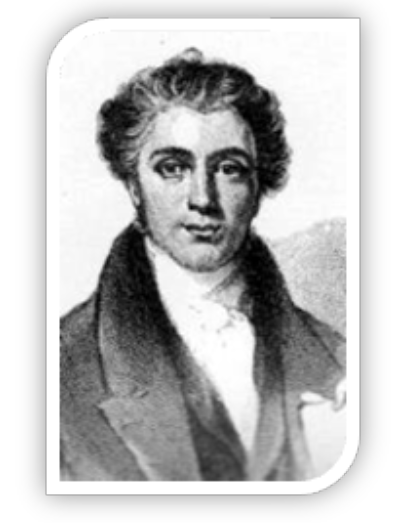
Left: A portrait of Thomas Rawson Taylor (1807-1835) contained in a volume, published in 1836, about his short life.
Research by Andrea Hartley and Alan Howe.
Written by Alan Howe.
March 2017
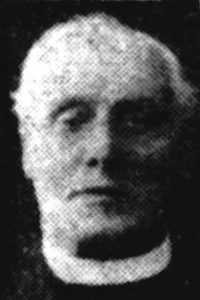
 John Hartley’s marriage to Susey Bland in 1845 officiated by Reverend Patrick Bronte.
John Hartley’s marriage to Susey Bland in 1845 officiated by Reverend Patrick Bronte.
 Family grave of John & Sarah Hartley and their second son, James. At Haworth St. Michael’s & All Angels
Inscription:
“Ring Out The False Ring In The True”
Beneath Rest The Remains of Sarah
The Beloved Wife of John Hartley, of West Lane,
Who Died June 14th 1901 In Her 78th Year. Also of the Above John Hartley,
Who Died At Barnburgh Rectory June 9th 1904,
In His 81st Year.
Mary Jane,Wife of James Hartley Born Jan.1st 1860,
Died Jan.23rd 1911.
Also of the Above James Hartley,
Born April 27th 1859, Died Oct.3rd 1933,
For 55 Years A Bellringer At This Church.
Family grave of John & Sarah Hartley and their second son, James. At Haworth St. Michael’s & All Angels
Inscription:
“Ring Out The False Ring In The True”
Beneath Rest The Remains of Sarah
The Beloved Wife of John Hartley, of West Lane,
Who Died June 14th 1901 In Her 78th Year. Also of the Above John Hartley,
Who Died At Barnburgh Rectory June 9th 1904,
In His 81st Year.
Mary Jane,Wife of James Hartley Born Jan.1st 1860,
Died Jan.23rd 1911.
Also of the Above James Hartley,
Born April 27th 1859, Died Oct.3rd 1933,
For 55 Years A Bellringer At This Church.
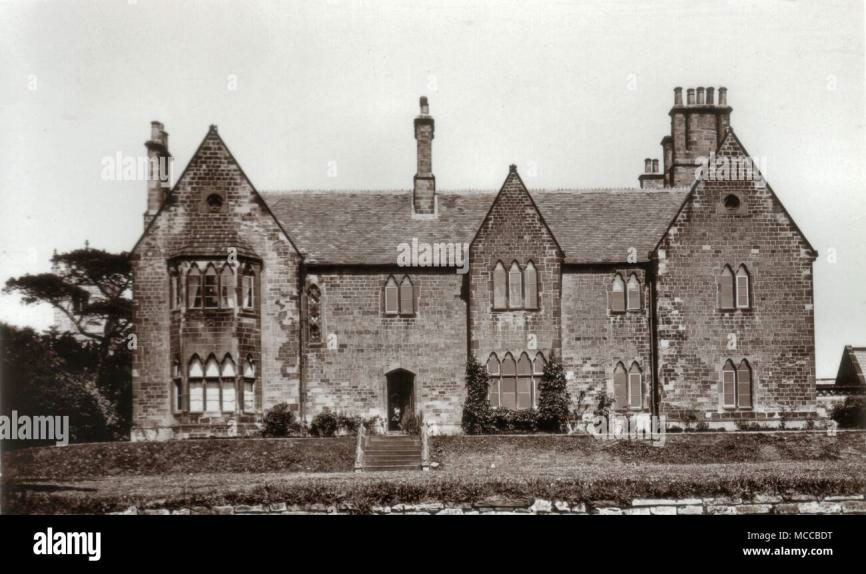
 In his civilian life Winchcombe was a bank cashier. His army service record has not survived with the result that the date of his enlistment and embarkation is uncertain. He was awarded the British and Victory Medals for service in an overseas theatre of war but he did not qualify for the award of the 1914-15 Star which tells us that he did not serve overseas until on or later than 1st January 1916. He may have served in the Royal Fusiliers before joining the Royal Field Artillery (RFA). None of his surviving army records tell of his brigade or unit which also makes it impossible to determine where he served when overseas. Royal Field Artillery cap badge opposite.
The Royal Field Artillery (RFA) was organised into brigades and was the most numerous arm of the British artillery. The horse-drawn RFA was responsible for the medium calibre guns and howitzers deployed close to the front line and consequently it needed to be reasonably mobile. During the war, the army deployed trench mortars, a whole new form of artillery developed to meet the unusual conditions of war on the Western Front. The lighter mortars were manned by the regiments of infantry, while the RFA provided the manpower for the heavier mortars.
During Winchcombe’s army service he suffered a disability resulting in his discharge from the Army on 5th June 1919. In August 1920 he was awarded a pension, payable for a year, with a similar allowance for his wife, Mabel (nee Croft)whom he married in the Ripon area in 1917. Their only child, William Howard Hartley was born in 1918. Winchcombe and his family appear to have lived at Barnburgh Rectory between 1902 and 1942. Sadly his father, the reverend William Robert died at The Rectory on 12th June 1942, aged 86 years. Winchcombe, aged 52, died five weeks later on 18th July 1942. His wife, Mabel, died in 1951 and their son, William Howard Hartley lived to be 97 years old and he died in 2015.
Winchcombe Henry Howard Hartley of The Rectory Barnsburgh was buried at St. Peter’s Church Barnsburgh on 21st July 1942 just five weeks after his father was also buried at St. Peter’s.
The unusual first name, Winchcombe, may suggest a link with the eponymous medieval market town in the Cotswold hills of Gloucestershire. That may be the case but then another Winchcombe Henry Howard Hartley, a vicar, turns up in Berkshire in 1819 after matriculating at Merton College in 1806, aged 18 years . He died in 1832.
Then an earlier Winchcombe Henry Hartley also of Merton College, aged 17, in 1790, B.A., in 1794, M.A. 1797 a barrister at law, Lincoln’s Inn. A third Winchcombe Henry Hartley this time at Corpus Christi College born in 1740, M.P. Berkshire 1776-84; died 1794. Closer to home is Winchcombe Henry Savile of Tickhill, Merton College matriculated 1819, aged 18. There’s another story here…but that’s for another day.
In his civilian life Winchcombe was a bank cashier. His army service record has not survived with the result that the date of his enlistment and embarkation is uncertain. He was awarded the British and Victory Medals for service in an overseas theatre of war but he did not qualify for the award of the 1914-15 Star which tells us that he did not serve overseas until on or later than 1st January 1916. He may have served in the Royal Fusiliers before joining the Royal Field Artillery (RFA). None of his surviving army records tell of his brigade or unit which also makes it impossible to determine where he served when overseas. Royal Field Artillery cap badge opposite.
The Royal Field Artillery (RFA) was organised into brigades and was the most numerous arm of the British artillery. The horse-drawn RFA was responsible for the medium calibre guns and howitzers deployed close to the front line and consequently it needed to be reasonably mobile. During the war, the army deployed trench mortars, a whole new form of artillery developed to meet the unusual conditions of war on the Western Front. The lighter mortars were manned by the regiments of infantry, while the RFA provided the manpower for the heavier mortars.
During Winchcombe’s army service he suffered a disability resulting in his discharge from the Army on 5th June 1919. In August 1920 he was awarded a pension, payable for a year, with a similar allowance for his wife, Mabel (nee Croft)whom he married in the Ripon area in 1917. Their only child, William Howard Hartley was born in 1918. Winchcombe and his family appear to have lived at Barnburgh Rectory between 1902 and 1942. Sadly his father, the reverend William Robert died at The Rectory on 12th June 1942, aged 86 years. Winchcombe, aged 52, died five weeks later on 18th July 1942. His wife, Mabel, died in 1951 and their son, William Howard Hartley lived to be 97 years old and he died in 2015.
Winchcombe Henry Howard Hartley of The Rectory Barnsburgh was buried at St. Peter’s Church Barnsburgh on 21st July 1942 just five weeks after his father was also buried at St. Peter’s.
The unusual first name, Winchcombe, may suggest a link with the eponymous medieval market town in the Cotswold hills of Gloucestershire. That may be the case but then another Winchcombe Henry Howard Hartley, a vicar, turns up in Berkshire in 1819 after matriculating at Merton College in 1806, aged 18 years . He died in 1832.
Then an earlier Winchcombe Henry Hartley also of Merton College, aged 17, in 1790, B.A., in 1794, M.A. 1797 a barrister at law, Lincoln’s Inn. A third Winchcombe Henry Hartley this time at Corpus Christi College born in 1740, M.P. Berkshire 1776-84; died 1794. Closer to home is Winchcombe Henry Savile of Tickhill, Merton College matriculated 1819, aged 18. There’s another story here…but that’s for another day.
 William Ismay Spooner Hartley, the second son, was born in Ossett on 18th May 1891 and baptised at Holy Trinity Church on 13th July 1891.
William studied at Queen’s College, Oxford from 1910, when he was 19 years of age. Having gained a B.A. in 1915 he moved to King William’s College, Castletown, Isle of Man, as Master of the Lower Fourth. He left at Christmas 1915 to join up, having previously applied twice but each time he was rejected because of poor eyesight.
On 21st January 1916 he was appointed temporary second Lieutenant (on probation) in the 8th battalion KOYLI. It is probable that he embarked for France shortly afterwards and joined up with the 8th Battalion KOYLI who had moved to France in August 1915. William was posthumously awarded the British and Victory medals for service overseas in a theatre of war. He was not awarded the 1914-15 Star indicating that he did not serve overseas until on or after 1st January 1916.
2nd Lieutenant William Ismay Spooner Hartley was killed in action, aged 25 years, on 1st July 1916. This fateful day was the first day of the Battle of the Somme, in northern France. It was to be the bloodiest day in the history of the British Army and
one of the most infamous days of World War One. On that day the British forces suffered 57,470 casualties, including 19,240 fatalities. The British gained just three square miles of territory.
The casualties in the 8th KOYLI during the day amounted to 10 officers killed, 14 wounded and one missing; of other ranks 35 were returned killed, 122 missing and 365 wounded reached the dressing – stations. One of the names of those 10 officers killed on 1st July 1916 was 2nd Lieutenant W. I.S. Hartley, aged 25 years.William is buried at grave IV. H. 1., Blighty Valley Cemetery, Authuille Wood, north east of Albert, France.
After the war, William’s father, the Reverend William Robert Hartley sought and was granted permission from the Commonwealth War Graves Commission to bring back from France the wooden cross that was originally placed on his son’s grave. Reverend Hartley had the cross placed in the Chancel of St Peter’s Church, Barnburgh, Doncaster (of which he was Rector). He positioned the cross over the seat in the choir stalls where William used to sit before joining the forces.
More details of William’s young life and his tragic death can be seen at this link which also includes photographs of the Wooden Cross which once stood on William’s grave in France.
A detailed biography of William can be seen Here
William Ismay Spooner Hartley, the second son, was born in Ossett on 18th May 1891 and baptised at Holy Trinity Church on 13th July 1891.
William studied at Queen’s College, Oxford from 1910, when he was 19 years of age. Having gained a B.A. in 1915 he moved to King William’s College, Castletown, Isle of Man, as Master of the Lower Fourth. He left at Christmas 1915 to join up, having previously applied twice but each time he was rejected because of poor eyesight.
On 21st January 1916 he was appointed temporary second Lieutenant (on probation) in the 8th battalion KOYLI. It is probable that he embarked for France shortly afterwards and joined up with the 8th Battalion KOYLI who had moved to France in August 1915. William was posthumously awarded the British and Victory medals for service overseas in a theatre of war. He was not awarded the 1914-15 Star indicating that he did not serve overseas until on or after 1st January 1916.
2nd Lieutenant William Ismay Spooner Hartley was killed in action, aged 25 years, on 1st July 1916. This fateful day was the first day of the Battle of the Somme, in northern France. It was to be the bloodiest day in the history of the British Army and
one of the most infamous days of World War One. On that day the British forces suffered 57,470 casualties, including 19,240 fatalities. The British gained just three square miles of territory.
The casualties in the 8th KOYLI during the day amounted to 10 officers killed, 14 wounded and one missing; of other ranks 35 were returned killed, 122 missing and 365 wounded reached the dressing – stations. One of the names of those 10 officers killed on 1st July 1916 was 2nd Lieutenant W. I.S. Hartley, aged 25 years.William is buried at grave IV. H. 1., Blighty Valley Cemetery, Authuille Wood, north east of Albert, France.
After the war, William’s father, the Reverend William Robert Hartley sought and was granted permission from the Commonwealth War Graves Commission to bring back from France the wooden cross that was originally placed on his son’s grave. Reverend Hartley had the cross placed in the Chancel of St Peter’s Church, Barnburgh, Doncaster (of which he was Rector). He positioned the cross over the seat in the choir stalls where William used to sit before joining the forces.
More details of William’s young life and his tragic death can be seen at this link which also includes photographs of the Wooden Cross which once stood on William’s grave in France.
A detailed biography of William can be seen Here
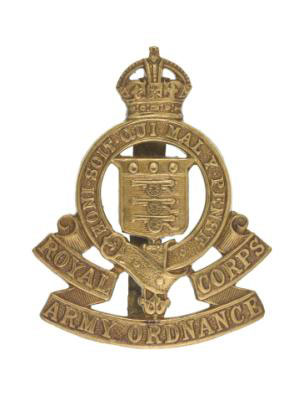 George, the third son of William Robert and Sarah Alice Ismay Spooner Hartley, was born and baptised in 1895 at Stanhope, County Durham following the move by his father, reverend William Robert Hartley who was appointed Vicar of Rookhope in 1892 after five years at Ossett as curate. George took his name from his uncle.
George was 19 years old when war was declared in August 1914 and he was old enough to serve overseas. His army service record has not survived with the result that the date of his enlistment and embarkation is uncertain. However it is known that he joined the Royal Army Ordnance Corps (Cap Badge opposite).
The Royal Army Ordnance Corps (RAOC) was a supply and repair corps of the British Army. In the supply area it had responsibility for weapons, armoured vehicles and other military equipment, ammunition and clothing and certain minor functions such as laundry, mobile baths and photography. The RAOC was also responsible for a major element of the repair of Army equipment.
George Albany Brigg Hartley was awarded the British and Victory Medals for service in an overseas theatre of war but he did not qualify for the award of the 1914-15 Star which tells us that he did not serve overseas until on or later than 1st January 1916. It is likely therefore that he enlisted and trained during 1915, embarking no sooner than 1916. None of his surviving army records tell of his battalion or unit which also makes it impossible to determine where he served when overseas.At the end of his war, George was placed on Z Reserve on 10th October 1919 which suggests that he was demobilised that month even though his address in 1918 was Boroughbridge Road, Knaresborough.
George, the third son of William Robert and Sarah Alice Ismay Spooner Hartley, was born and baptised in 1895 at Stanhope, County Durham following the move by his father, reverend William Robert Hartley who was appointed Vicar of Rookhope in 1892 after five years at Ossett as curate. George took his name from his uncle.
George was 19 years old when war was declared in August 1914 and he was old enough to serve overseas. His army service record has not survived with the result that the date of his enlistment and embarkation is uncertain. However it is known that he joined the Royal Army Ordnance Corps (Cap Badge opposite).
The Royal Army Ordnance Corps (RAOC) was a supply and repair corps of the British Army. In the supply area it had responsibility for weapons, armoured vehicles and other military equipment, ammunition and clothing and certain minor functions such as laundry, mobile baths and photography. The RAOC was also responsible for a major element of the repair of Army equipment.
George Albany Brigg Hartley was awarded the British and Victory Medals for service in an overseas theatre of war but he did not qualify for the award of the 1914-15 Star which tells us that he did not serve overseas until on or later than 1st January 1916. It is likely therefore that he enlisted and trained during 1915, embarking no sooner than 1916. None of his surviving army records tell of his battalion or unit which also makes it impossible to determine where he served when overseas.At the end of his war, George was placed on Z Reserve on 10th October 1919 which suggests that he was demobilised that month even though his address in 1918 was Boroughbridge Road, Knaresborough.
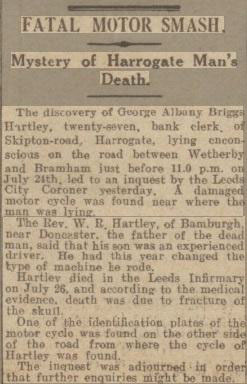 Sadly in July 1923 George Albany Brigg Hartley, a bank clerk of Skipton Road, Harrogate died aged 27 years following a motor cycle accident on the Great North Road between Wetherby and Bramham on 24th July 1923 which resulted in his death at Leeds Infirmary two days later. The Leeds Mercury of 28th July 1928 carried news of the accident.
No other vehicle was involved and a month later in August 1923 the Inquest found a verdict of accidental death.
Reverend William Robert and his wife Sarah Alice Hartley had lost two of their four sons in tragic circumstances between 1st July 1916 and 26th July 1923.
Sadly in July 1923 George Albany Brigg Hartley, a bank clerk of Skipton Road, Harrogate died aged 27 years following a motor cycle accident on the Great North Road between Wetherby and Bramham on 24th July 1923 which resulted in his death at Leeds Infirmary two days later. The Leeds Mercury of 28th July 1928 carried news of the accident.
No other vehicle was involved and a month later in August 1923 the Inquest found a verdict of accidental death.
Reverend William Robert and his wife Sarah Alice Hartley had lost two of their four sons in tragic circumstances between 1st July 1916 and 26th July 1923.
